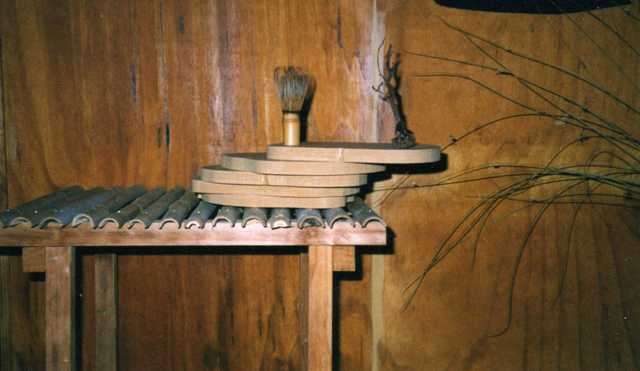When I look back the project, I see how many people have helped us!
Since we started to work at the site in the end of 1991, Kaiwaka
(written as KW) accepted us with a warm and kind heart. People at the
supermarket, at the post office, passing people, etc, have all welcomed
us. It is difficult to find this atmosphere in a city these days.
Another reason could be found that my then partner was a European,
noble-minded and cultural. Since I, Japanese, started the project, I
never felt what they call racial prejudice. It is a foreign country for
me and I felt in fact if we could melt into them. I am very fortunate
as I was able to get a lot of help in many different ways. It is
natural that they become exclusive if their quiet and peaceful village
is invaded with dirty shoes on, like a huge capital. They never welcome
these people who disturb their established village with power. Though I
don't know what kinds of people I will meet in the future, it will be a
life which I could not have had in Japan. I want to write this chapter
about New Zealand, tradesmen, neighbors, etc with published essays even
from my diary, especially, about the music gathering at our
amphitheatre which became an annual village event.
(1)Green country New Zealand
The greenness of New Zealand has two aspects, one is of great nature
and another is pastoral. Its area is 80% of Japan, it has four million
people, and the population density is little, especially compared to
the Japanese. However, they had 70 million sheep - now 5.8million - and
their contribution to the global warming is great. It can not be talked
with its human population.
In the South Island, the Canterbury field is used for agriculture but
other areas are kept for great nature partly because of the severe
climate. Milford Sound is deeper than 500m surrounded by precipitous
cliffs and there are nice trekking courses around. Some of them need
booking. Lake Manapouri and its hydroelectric power plant are
interesting. It uses 178m water level difference from the sea and
supplies electricity for a near town where aluminum is smelted. They
can be accessed from Te Anau or Queenstown.
If one goes up to the North along the east coast which faces the
Pacific Ocean, there is the Maeraki Boulders that have many round
boulders of more than 1 meter in diameter sticking out the sandy cliff
and being distributed on the beach.Christchurch is the largest city in
the South Island and is often called the 'Garden City'. It offers an
access to the highest mountain in NZ, Mt Cook and it also has Mt Hutt
for skiing in the winter. However, Mt Hutt gets three quarters of their
skiers from Japan and their Kamikaze skiing increases. The number of
people getting injured and get flown to Christchurch hospital which
gives the Japanese a bad reputation.
It is said that the western side of the Mt. Cook range has a few nice
glaciers. The Abel Tasman National Park based from Nelson offers a
variety of ways to enjoy its wonderful nature. Railways are not well
developed as it is in Japan. Public transportation relies mainly on
buses or cars. Local buses serve only a few times on a day even along
main state high ways. Preparation must be done collecting adequate
information beforehand. Motels are here and there and are very well
furnished and there are even cooking tools, knife and forks, a
refrigerator, etc, in the kitchen. One can cook there as he wants,
buying grocery at nearby shops. An accommodation called a backpacker
offers a room for a few people with inexpensive charge and is
distributed at many places through New Zealand.
When we travel from the bottom of the Northland, there is Mt. Taranaki
which looks like Mt. Fuji, National Park of Mt. Ruapeihu next to it,
Lake Taupo north to it, where we can enjoy fishing, Rotorua where a lot
of Maori people live using hot springs, etc. They are Polynesian former
inhabitants for New Zealand. Their population is ca 13% but their land
is ca 5%. There are a few social problems including land use. They have
the same philosophy of American Indian Chief Seattle that the land must
be commonly used with flowers, grass, trees, insects, birds, animals
etc. It is quite interesting to see how they live using hot springs and
doing wood carvings.
There are many genuine, honest and polite people being grown in nature
surroundings.
We can not talk about this country without former inhabitants Maori.
The English people started to colonize it in the early 1800. They had
own schools before then. They did not have characters and transferred
their knowledge orally by teachers who were called Tohanga. At the
English colonization the schools were suddenly closed. A European
published a book titled "Song of Whaitaha" who did enthusiastic
research on the then background having the elders and Tohangas
permissions. They thought it was an opportunity to tell the public
about it too.
Time goes back even 2000 years ago. It says that they originated from
the Easter Island where Asians and Europeans encountered. They were
oceanic people. They bred mussels under a raft to take with them when
sailing, to use them for food and bait for fishing from the boat. They
supplied sweet water on the ocean as well. Isn't it interesting that
most of the fishes have sweet water living in the salt water?
They could read the ocean stream when sailing, the location of stars,
and a flying direction of sea birds. They got a big boat which could
accept 172 men and women with food. Women had to have kumara (sweet
potatoes) under their breasts. It only took 13 days to get to New
Zealand. They called the island "Aotearoa" which means "the island of
trailing white clouds".
The battles between tribes often happened. Their languages were
somewhat different. I was told that the Rangitoto Mountain which is a
symbolic volcanic mountain for Auckland is translated as “Red
blood” by one tribe and another tribe translates it as
“Red
sky father”.
Hamilton is regularly planned in a grid like other modern cities. It
was the time when they were discussing the 25 years urban renewal.
Seven tribes got the queen and there is a meeting place called a Marae
for them. A group of students and a professor who helped the renewal
planning were invited to the Marae to talk with the Maori and he told
us to join. It had developed along the Waikato River which brought
fertile land. The area is quite industrialized and contaminated. When
one of the elders looked down from the mountain top recently, he
grieved how badly the area was contaminated. He started to tell his
expectation for the renewal but his concern was if Pakiha-they call
Europeans distinguishing from Maori- could understand their grief and
stand points. He was negative if they can take in their points. They
believe that the moment when they feel sleepy is the time for one's
soul to be most free and precious. Speeches and discussions continued
until early in the morning. Each nation's culture is rich and noble.
The Maori language is interesting for us Japanese. They have five
vowels as we do. Each syllable has a vowel after a consonant and is
spoken phonetically and clearly. They have r but no l. They have words
refrained, Kerikeri, Piyopiyo etc as we have. "Kamatte Kamatte" sounds
like "Ganbatte Ganbatte" for cheering up in Japanese. "Tenakoto
Tenakoto" looks to exist in our western local language. Kai of our town
Kaiwaka means foods (by the way 'waka' means a boat.). It means a shell
in our language and reminds a mound of sea shells at the excavation of
old village sites.
Before I got the strong impression from the Maori elder's talk, I got a
letter from the American Indian chief Seattle replying to the then
American president when he was asked to sell his tribe's land. It was
written in 1854. He could not understand the meaning of possessing a
land. I felt that people who love nature have the common mind. I let my
students read it in the last several years before I resigned.
It is a fact that they tend to prefer cheaper price and they build
houses, office buildings, and markets to give priority on functions and
result in poor designs. They can stand the winter with hot water
bottles, and don't mind to be tattered. Food is not expensive and their
daily lives are established to be relaxed. However, it is true that
their cultural aspects are poor. There is no colorful culture as there
is in Europe. Towns spread without any cultural cores but sprawling
like it has been recently in Japan and the USA. It is not impressive
but it is full of nature. It gives better persuasion than the cheap
culture. It is great that the dairy product of the country of 4
millions (0.07% of the world population) gets 1.5% of the world
production. On the other hand, it is apparent that its contribution to
the global warming and the ozone layer depletion is great. It is asked
how it could be changed. The ozone hole depletion is not only a
problem. People's minds which have produced the present situation will
be questioned.
(2) Looking back the construction site
While I was on the staff for the Architectural Department, in the
faculty of Engineering, Kansai University, I subscribed to a few short
reports on campus journals on the construction site. They are given
here to look back at the early stage of the site construction.
The project was started as a New Year’s resolution in 1990.
One
of my friends in NZ, Senior Lecturer for AKL Univ. Dr. George Dodd
visited me at my lab in February that year. When I talked about it to
him, he recommended me to come to NZ because the land there is not that
expensive. I had a few other friends at the School of Architecture
there and thought that it would be helpful for my students'
internationalization. Additionally, a post which had been for our
Architectural Environmental Engineering was taken by Structural
Engineering and the Department turned to be composed mainly by the
Structural Engineering (four professors for it, one for Architectural
design, and one for Architectural history). I felt that the future
development of my lab was hopeless having an increasing importance.
This process will be mentioned later again. Finally, I decided to have
the site in NZ.
I started to get donations from construction companies, Acoustic
consultant offices etc. It was fortunately just before the bubble
economy collapsed. I got enough funds to start the project with
confidence; especially the ones from the Kenon Acoustic consultant and
the Sekisui Housing are appreciated. Some friends in NZ were very
helpful too.
The construction site started in December 1991 having a ground-breaking
ceremony with sake, rice wine. The hill top was evened and a hole of
10m x 8m and 4m deep was excavated for a basement. Concrete block
layers made a large concrete box reinforced by iron bars. Six Hume
concrete pipes of 30cm was inside the diameter for cool tubes which
were safely buried 3.2m below the surface, having thermo-couples at
places for later monitoring. Excavator operator Des observed carefully
from his machine for any collapses while our plumber Bruce Tomlinson
placed the thermo-couples in. The basement had a 40cm layer of crushed
pebbles outside the walls, and in the bottom perforated pipes were
placed surrounding the basement. Rain water is collected through the
pipes not to lift the basement but released to the creek from the end
of the pipe. The outside wall was water-proofed. All the work was
directed by Denis with his experienced knowledge.
2x4 construction is popular in NZ too, called 4x2. Our builder Steve
Lomax experienced profoundly the structure. He pointed that the
designed truss was too heavy and to make it lighter. He even organized
a structure engineer to check it. I appreciated him for doing this for
me as I could save a lot of money. It was a profound intuition by a
well experienced builder.
Trusses that were assembled at a factory were piled to the top. After
the last truss was put on, we celebrated the house rising on April 4,
1992. Every country looks to have a ceremony with appreciation not to
have had any accidents when the most dangerous structural work is
finished. They put up a branch, or a little flag. I made a Japanese one
with white paper on a branch of a local t rimu tree and put it on the
top, appreciating the safe work.
In the meantime, two wind mills of 400watt generation and one of
300watt were installed on pine tree posts.
There was a little international conference on "Earth building" at the
Univ. of Auckland and I gave a talk on Japanese clay walls. I met David
Studhlme who was a member of the National Historic Trust and showed a
clay house with a thatched roof. He came over from the South Island to
discuss clay walls. He offered to help me with the cobbing.
For a 2x4 construction, they nail plywood in place for bracing. When we
were not at the site, our builders kept working and the house was
clothed with plywood in June.
During the summer vacation in 1992, we planned to put a bamboo lath
"komai" on the walls. But we found that it took too much time, and we
decided to instead use wooden battens to be stapled. Ron Hutt, a friend
of David’s, came over and we stitched the "komai" lath.Bruce
introduced to us a roll of wool fleece recently developed for thermal
insulation and sound absorption which was commercialized in NZ. Fiber
glass has a lot of problems as a building material. It will be an
interesting building material which is nature friendly. The cost is 1.5
times the cost of fiber glass. Triple glazed windows were fit in and it
looked like a house.
In the Meantime, I gave a talk at the tenth conference for "Passive and
Low Energy Architecture (PLEA)". Before the conference a friend of mine
at AKL Univ. Tony Watkins brought the president of the conference,
Prof. Cook, Arizona State Univ., Prof. K. Kimura, Waseda Univ. and Dr.
Y. Kodama, Architectural Institute of Japan, and we had a useful
discussion.
We could have a shower in the house from Sept 1st onwards. Before then
we had a caravan life, fetching water, a candle light and a long drop.
It is called a nature-friendly outside toilet. A shed was placed on a
hole of about 4m deep. It still remains in my mind as a nice memory of
looking up at the twinkling sky.
It took about 700yen per day per person, but we had good food even a
beef steak once in 3 or 4 days. I already took seventeen undergraduate
and graduate students. Two of them were invited to the local primary
school and enjoyed talking with children. I hope all of them got good
experiences.
In October and November, a friend of mine had a very hard job working
with unemployed people to collect bulrushes in the field for thatching
material. Norbert Kleinschmidt who finished the immigration process
from Germany could start to thatch the roof from December. He brought
his family and worked from early in the morning to late in the evening.
The predicted bundles for the roof were less estimated because bulrush
is thinner than water reed. Half of the roof was thatched and the rest
will be done in the next year. It is quite different from the
commercial building materials which are easy to supply. A subject
remains.
After the site was started, a few media accessed us. But there was not
much to introduce and they had to wait until Norbert started to thatch.
When the thatching had come to the end of the first stage we called
them. Its copy is given in Fig.3-2-1. In the article I am titled as a
professor. I didn’t personate myself to be titled as an
associate
professor. They are called together as a professor. They were quite
interested in our project. On radio or TV they reported it as a news
program. The location is at a remote place but over a hundred people
visited the site. It is hard work to accept them, but each one has his
or her opinion and I enjoyed having a discussion.
While I was not here, our builder stapled wooden battens on the ply
wood walls, and we could cub in March and April in the New Year. David
and Ron, whom was already mentioned, came along, an Italian plasterer
Gino Bianca joined us, and we got local helpers and my students. The
cobbing was quickly preceded.
We learnt a lot of things through the caravan life. Daily garbage
bothered us and left us
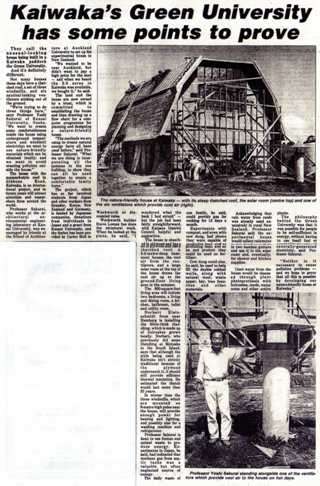
Fig.3-2-1 A report about our project on a local news paper.
to think. We collected off-cuts for later use, but we learnt that they
can not be used for fuel to cook because of their treatment for borers
and decomposition. If they are buried or burnt, grass can not grow
there. I chucked them at a local dump following the strong suggestion
from our neighbor. I was concerned how it would be later on. Is the
treatment really necessary?
Fig3-2-2
Experimental House in September, 1993 (omitted).
Plastic rubbishes were produced just like at a usual family. Just
before I left Japan this March, I watched TV news on the reproduction
of petrol from plastics. I hope it will be developed practically.
Materials and/or products which once used large energy must be recycled
or reused, I mean.
When I worked on the impact noise reduction for the Japanese High
School Baseball Association, I was told that broken aluminum baseball
bats are collected and recycled.
The construction site in Sept, '93 is shown in Fig3-2-2. Windmills
produce electricity for lights and a little refrigerator. When it
blows, a washing machine, vacuum cleaner etc can be operated. Biogas
from the septic tank can be used for cooking. The inventor says it
produces 12 days of cooking energy from 30 days of excrement and
garbage. The main interior work is finished. A sofa, a dining table etc
were brought in and now we can live in the house. This winter was
unusually cold, the outside temperature dropped to zero and the inside
temperature was kept above 9 degrees. We tried not to use any heaters,
but wore thick clothing instead. After the bubble economy collapsed, it
turned very difficult to collect donations. However, as we got further
donations having a good understanding towards the project and I spent
my private money, we got 75% of the construction which I planned in the
beginning and I believe we can overcome the difficulty. The amount of
money which was raised from December 1991 to now is a bit over
30,000,000 yen and it was spent for the construction, the
transportation, the staying expenditure, etc.
When we look back at the site work, we did a lot of dangerous work,
e.g. setting a scaffold at 10m above the ground. I appreciate
God’s help for preventing any serious injuries among
tradesmen
and companied students.
To be nature-friendly and sustainable
A variety of words appear when we talk about global or earth
environments. Once we expressed this project as an experimental house
project to be kind to the earth and were criticized that it expresses
the human arrogance. It is true. As Chief Seattle says, nature lets us
to live on the earth. In the English expression, there are ones, e.g.
nature friendly, zero energy, ecological, self-sustainable,
perma-culture, low-tech, environmental etc. They are quite direct
expressions. At this stage, we express our house as a nature-friendly
experimental house and the project as the sustainable research project.
On the flow chart for the computer program to support an architect, an
estimation function for the sustainability is introduced as an
independent factor. It is very important to know quantitatively (MJ/kg)
how much energy was used for not only building materials but all the
materials involved in building a house. For building materials they are
collected, e.g.
|
Used energy (MJ/kg) |
| Iron |
30 - 60 |
| Aluminum |
100 - 270 |
| Glass |
12 - 24 |
| Polystyrene |
100 - 140 |
| Wood |
0.5 - 6 |
| Paper |
45 |
| Earth |
0 - 0.5 |
| Concrete |
8 |
Energetically discussion is necessary about a food. Animal protein
needs 40-100(MJ/kg) to produce and the one for plant protein
4-6(MJ/kg). The former needs more than 10 times. Eating habits should
be discussed from this aspect and cooking way from each corner in the
world can cooperate to create a new direction.
Besides, the following parameters are important to compose a proper
scale to estimate sustainability.
• Energy consumption at
construction process and the way how it is used
• Durability of each material
• Energy to maintain a house
• Permanence and long life with
the design of a house.
For
instance if furniture are well designed, they are cherished and last
long. A house must be designed well to be kept longer. Unfortunately, I
have never seen such poorly designed Japanese houses in any other
countries. They are not created in the space but are a collection of
new building materials. An architect has a very important role.
• Toxicity of materials
• Every material used certain
amount energy. How it can be recycled and/or reused?
When these items are picked up and you see them, it is evident that we
have to think about various factors to make an estimation function for
sustainability. It must be used for building and/or renovating every
house.
It could be a measure to get points in positive or negative referring
to the experimental house here for each item and to have the total
score.
Increasing responsibility for a university
Many of the Europeans who introduced materialism and developed have
begun to think about the environment seriously and do practical
activities. Their concerns occupy each one's mind heavily. Even in
natureful NZ, many people are concerned about them. News papers,
radios, TVs etc report on this project are the reflection of them.
School children who visit the site know well about the green house
effect and the ozone layer depletion. They are taught at school. On the
other hand, how are they taught in Japan? Are they only keen to prepare
for entrance examinations? For the protection of environments early
time education is essential and fundamental.
When we observe the situation, it looks like a time when Japan
strengthened the military force with the then technology before the
World War 2, being a frog in a well. Am I the only person to feel like
that? Especially recent technology has been developed to serve
materialism, or worse to say, had been used as a device to get money.
It is the time for it to serve for the environments which it has harmed.
Technology must enrich a human life, especially Architecture is a field
to think over the way synthetically. However, it is a narrow split into
special branches and the relationships with other related fields are
not concerned or they can not discuss them. In this department, a
structural engineering professor was keen to bring his friend of his
field. Finally it was composed with four structural engineering
professors out of 6 professors. It is composed completely different
from the original philosophy of Architecture.
Recently
I read a book written about an unusual society of a Japanese
university and how they are out of common senses. Is this a choice that
can be allowed in out dept because it is a closed society in a Japanese
university? I believe that a university has a role to criticize the
society and make it progress. It can never be done with this easy
going. The future of a university is in crisis if a choice is done in
such a way. I recommend readers to read it. The author’s
family
name is the same as mine but I don't have any personal relation with
him by the
way.
K. Sakurai, "University professors-too typical Japanese", Taninshokan,
Nov, 1992.
An Architecture treated at a university is so separated from the
practical field. It looks to be made or constructed on one's concept
without knowing any practical field works. After we built our
experimental house, I got a lot of knowledge and will learn a lot more
there. I believe that the practical site has a proper field to be
studied for Architecture.
Tradesmen in NZ are quite interested in this project with active and
practical attitude which is different from university people. A
tradesman tries to grasp a house construction as a whole, even though
it is not his own trade. People who call themselves specialized tend to
talk only on their regions but people at a site are different. And the
science there does not ask which university he graduated from. The
impression and the attitude are far from the practical interests and
disappoint students. It makes them just have a title to enter the
society. I feel sad that a student attitude reflects the atmosphere.
The experimental house is located in rich green environments and has
many kinds of birds: a pukeko-a native black bird, a rosera-a colorful
beautiful bird, a ruru-an owl, a pheasant, a wood pigeon and so on. The
green university (see the headline in Fig3-2-1) is going to realize the
previously mentioned four items, i.e. natural energy use, local
material use, no contamination and self-sufficiency, and review and use
the knowledge which has been developed nature-friendly without changing
this environment.
It does not mean only the application of technological knowledge, but
we want to coexist the human basic aspects, e.g. music, arts etc. We
want to have the site to express ourselves freely, making ropes and
grass sandals, papermaking, music at an amphitheatre, gardening, and
arts in this green environments.
One of the hill slopes has the similar angle of a Greek amphitheatre
(26.3degrees). We will use it for an amphitheatre to invite local
musicians. Namely, the reflection from the front becomes less as this
steep slope and the direct sound from the stage reaches very clear
towards the audience. A friend of ours, Nichole Nulden, who got an
award after Ashkenazy at the Paris piano competition, promised to play
for us. We are looking forward to having her play at the opening
ceremony.
Why did two guys from Waimate, South Island come over to help us
enthusiastically after traveling a long distance? It was nothing but
human love. We hope the site will be filled with it. Practical
workshops are being composed for wall cobbing with David Studholme and
Ron Hutt, for thatching with Norbert Kleinschmidt, for a septic tank
with Bruce Tomlinson and so on. Dick Aynsley for wind engineering, the
Head for School of Architecture, AKL Univ. is helpful and supporting.
The number of nationality is over 10 and the site is going to be more
international.
When the project progress is explained in this way, everything looks to
have been favorably done. It was not always like that. The impression
of Japan in foreign countries is not well reputed in general. They
tended to charge more money because they are cheaply rich. It is also
criticized for its poor spiritual aspect. It has a certain limit for an
individual to change it. It is yet a difficult issue for us Japanese to
be internationalized.
When the construction of the experimental house was reported on TV news
telling people that a scientist may give us a blue print for a future
house design, it is not easy to realize. Rain water can be collected
from the roof and only 75% of demand referred to the past statistically
obtained amount if it is collected in the rainiest month. The biogas
from the septic tank supplies only 40% energy for cooking if what the
inventor's say is correct. We must know how much energy the windmills
spend on the production process. If the carbon dioxide would be well
processed by photosynthesis after burning? All these discussions are
steadily being done.
If it is expressed negatively, it is a study to make it clear how much
energy is necessary for a human life and how does it eat up the earth.
Whatever it is, it is a challenge and a start to find a happy
sustainable way of living.
Lastly, I want to insist that we have to live in modest and humble not
only materialistically but spiritually, although it is very difficult
for people who are used to the consuming society.
Since 1991 we started the project, many internationals also started to
live in Kaiwaka; German, English, French, Hungarian, Dutch, Indian,
Romanian, Russian, Scotch, Swiss, American and so on. The local primary
school asked us to give a talk on "My primary school time", knowing
this situation. The following is my memorandum for that opportunity
telling the importance to learn in, for and with nature looking back my
childhood. I think it is very important to tell it to Japanese children
as well.
(My talk at KW Primary School on March 29, 2004)
My name is Yoshi. I am from Japan and live on Gibbons Rd. I have an
experimental house. I collect a variety of the solar energy. I grow
rice, veggies and fruits and want to be self-sufficient. It is very
important not to contaminate around and I cleanse with a septic tank
and three cleansing ponds in the green house. Once a year we have a
music gathering in autumn at our amphitheatre. I hope you will come to
our experimental house together.
The location of both countries was shown on a little globe with their
areas and population comparison. Our characters with examples of a
river and a fish were written. I told our original culture is fading
after the country was open because of the globalization.
I was born in 1938. I attended a kinder garden for two years but I was
a crybaby. My grand mother came with me. I entered a primary school at
seven years old. It was in 1945. It was just before the end of the
World War II. I wore a thick and deep coif to attend. Finally, our town
Kobe was bombed. Not only Hiroshima and Nagasaki, but most of big
cities in Japan were bombed and completely destroyed. And we
didn’t have any foods.
We ate rice as a main food. I got a bowlful of plain soup with a few
grains of rice for a meal. We got a ration of animal feed maize and
coconut powder. I remember I was always hungry. At that time my father
was taken to the Japanese army, I lived with my grand parents, my
mother and my brother. My grand parents did gardening at a small space
and taught me quite well about the way.
A strong memory is still in my mind when our text book was changed on
my desk for a new one. It was a symbolic moment from old Japan to new
Japan. I felt we must never have any wars.
Japan started to gradually recover from the destruction by the war. The
difference between rich and poor was becoming large. The same lunch was
given to children by their school and they got a uniform not to have
the difference between them reflecting the family's economical
situation. We learn a lot at school, but the strongest memory is that
we played in nature: swimming and fishing in the sea, a can kicking on
the road, catching dragon flies, cicadas and grass hoppers etc. It was
poor but we enjoyed playing baseball with a glove made of cloth. Though
I always felt hungry, it was a good old time for me. Japan is at the
zenith of materialism, I feel it was most joyful and happiest.
When I was 13 years old and finishing primary school, my teacher
recommended me to enter a middle school which has an entrance exam.
After three years of high school, an additional three years later for
university I had to have entrance exams.
Achievement test can not be a good measure to find one’s
personality and creativity. I never thought it was a good system, but
it is the reality in Japan.
Lastly I want to emphasize that each one has to have time to learn
nature.
NZ media come to me for interviews. In the beginning, a few local
papers, FM radio station, and TV3 news came over. After them National
Radio interviewed me on rice growing, Northern Advocate came also for
rice growing, Asia Down under on TV1 for the project as well as Kaipara
Lifestyler. One of them is given in Chapter 5.
Let's recall a moment when we felt joyful. Most of time we did not have
any scenario, it did not happen at a certain place, at a certain time
or even at thought, it happened suddenly. If we make a scenario and try
to find it, most of time it never happens as it is written. It is
created with a surrounding situation, being helped with additional
factors not on the scenario, and then we get a wonderful result of joy.
This is not an individual creation or a human work. A German song says
"A joy is an impulse from God - Beethoven’s ninth symphony
-." Or
“It does not need much to get a joy but if you get it, you
feel
like a king – from a German canon -." Don't they
express
aptly about a joy!
On our daily life we are not surprised or impressed when we see
reproducible and linear changes, e.g. music replayed on CD. However,
when we meet a non-linear change we feel impressed and amazed. Daily
appearance of the sun set or the sun rise with a play of the sun and
clouds, it is so great that no body can not express or create it. How
could we be closer to it? Compare it with a monotonous expression with
words. How rich space the joy we feel in nature is. Even a painting
shows a beautiful scene, it is still linear.
We should consider and try to express aiming a non-linear nature
creation. Then it will take us to an imaginary space and or a
meditation space.
Nichole, who was a Belgian pianist and played piano at the first music
gathering, put a lot of her own marks on her Brahms music notes. There
must be her feeling which can not be given only by the code on the five
lines. I felt like she was telling me that musical expression must not
insist on the reproduction but has a non-linear aspect. Additionally,
music is not a performance on the stage itself. It is always with an
audience. The wonderful fusion of a performer and the audience at every
music gathering is one of in-reproducible and non-linear aspects.
One thing is that if a time change is so fast, we can not follow it.
Even the change at sunset or sunrise can not be expressed. We avoid
expressing them into words. It is true that we can not feel relaxed
from a quick change. We must have potential rhythm, like the alpha
brain wave at relaxation, the preferred frequency spectrum with 1/f
(Hz).
Why can we simply think the sun is in the sky? The sunset and /or the
sunrise are cooperated with the earth, the scene becomes wonderful.
With the horizon they and increase our delight. Appreciation to the sun
and the earth.
When I do a simple observation, they express nature with its simulation
and try to have a new creation beyond it in Europe. Although it depends
on a geographical background, nobody likes to chase sheep with a minor
and melancholic environment. A major tone became the basic. It can be
said not only for sounds but also for paintings. They use a variety of
colors. It appears to be arrogant but looks seriously on how to live.
However, they think there is nature to be conquered and the target of
challenge. The attitude brought to GE, I think.
On the other hand, in the Asian area, especially in Japan, there exists
great nature first, and they tend to enjoy the atmosphere which is
introduced with little human’s disturbance. Minor is the
basic.
It looks to be easier as execution. If the development of thought is
stopped, it leaves it to nature. There might be the essence of life.
Recognizing that the eastern and western cultures have different
aspects and profiles, we should create a new stage. Fortunately, there
are multiple nations as well as the Kiwi locals gathered in KW as it
was mentioned before. It has a wonderful atmosphere and space.
The pleasure at a festival is one. It seems to have contact with a soul
world. There must be a lot of people who did not come out to the
surface in the society being underground or finished their lives
without expressing their established thoughts. However, God knows well
about them and gives them higher starts in the next plane. They need
not to complain about the bad luck. We have to gather their souls back.
A Japanese summer festival 'Obon' is a habit to think of those people
and to talk with them.
As a festival is often related with God and soul, we must not enjoy it
just as habitual, but find a joy thinking over the background. There
have been many habits to have contact with the soul world.
I think that we can only step into the next plane for the first time,
when we do not set our lives for the short time on the earth, but set
it to continue on to be influenced and reflected from our individual
earthly lives. With the flow of such a thought we can find the relation
even from the next plane, I think.
Most cultures have been flown to the direction of wealth. They should
be with nature. Under vernacularism a sustainable space produced a lot
of great culture. We have to review them carefully and never perish
them. Japan has lost many of them being poisoned by materialism in the
past 150 years. It is very difficult to create culture from a concrete
box. It looks like culture but it is only a molt from the artificial
space (see Fig.3-3-14).
It may be arrogant to think and pursue the soul world as the leader of
creation. If it exists in joy, a bird or a plant would have it. Their
monotonous -by a look-life could be the strongest way to survive. Us
humans squirm when changes have been made by themselves and then
proceed to the destruction.
What are we looking for between life and death? One of the sure things
is steady progress toward tomorrow. And it must be the process of an
effort to connect the earthly life to the next plane after death for
the spiritual development.
Then, what is the progress for tomorrow? Practically each one has to
have it depending on one's conditions and environments, because each
one is different. And when we think of human progress, we have to put
ourselves in great nature: birds, flowers, grass, plants, animals,
minerals, clouds, etc, which live around us, namely, all the things on
the earth, and start to develop it.
For that, precise observation and digestion, and the expression of
one's philosophy at painting and sculpturing, meditation with a
wonderful space spreads in front and one with its poetical expression
beyond to the fantasy world, performance feeling trees trembling,
chirping birds, literature at the practical research of a life purpose
and one to find any beauty, joy at solving a natural phenomenon. If we
don't have any of them every day, we can't find any meanings in our
life. Without these essences of a life, it does not mean anything even
for Architecture.
At the origin of a great result, there exists emotional and impressive
creation. However, its energy starts to fade because of formalization
and organization-most of time it is never done ideally- and it is
destroyed. If its development comes to deadlock, it is one way to go
back to the origin, I think. For instance, about a concert hall:
Gewanthaus in Leipzig was originally a square ball room. Music for
dancing sounded excellent and beautiful there, and they wanted to
listen to them only. I guess it was a start of a concert hall. Since
then quite a number of tries have done to improve a sound field of an
auditorium, especially on its shape, but none was successful beyond
Grosser Musik Vereinssaal in Wien that has a square shape called 'Shoe
box'. Recently, a few are going back to 'Shoe box'.
If we start anything it gives us the next step. Only collection of
knowledge does not give us anything. I have enjoyed the next new steps
on and on to have development. There I found joy. Even if they are
small joys I experienced to encounter a lot of them. For instance, on
Acoustics, I wrote a lot of papers with my colleagues. Terrible weed
kikuyu looks to include a lot of carbon in its hard stem and can be
used as fuel, and its ash goes for fertilizer. Rice grass is perennial
and gives a certain amount of harvest from its old root. If this is
certain, we can save time for sowing and transplanting. The solar
cooker got a glass cover with an air gap. It is just the use of the
green house effect. These results can not be obtained easily on the
process of mass production. We have to learn these kinds of things from
nature and observing it, feeling it, touching it. It is completely
different from the attitude to get anything through knowledge.
Additionally each one has to experience this for himself.
As birds, grass, flowers, skies, clouds etc are different in themselves
we human beings want to be different with each other. Then when we
create the wonderful natural harmony together, we may be able to peep
in the soul world.
Most of us forget the new and fresh morning feeling that day in which
we experienced in our childhood, don’t we? We have to
treasure
our sensitivity. We have to start without any hesitation if we feel
this is good, interesting, and/or useful. We have to create such an
atmosphere. Aging makes us feel as though time runs faster.
Joy is not always to feel high. There exists joy at pathos. Some old
Japanese houses had such atmosphere ‘wabi (humbleness)' and
‘sabi (agedness)'. Even kikuyu has a life from birth to death
and
goes back to the earth. It could create a non-linear space. A dry
flower could be one of them. To enjoy it only at the height of
flowering means to use its effort that took for a long time under the
sun's care. Enjoying its whole life and deepen the joy gives a
different aspect.
When I look back at my Acoustics, the steady individual effort has been
contributed towards human development, which is a social cooperation.
It is tiny logic given by an individual. However, its purpose is
distorted with greedy social demands so it is worse. It was never
connected to deep mind of nature. The real individual liberation is
considered to exist in that connection. The quality and level of a joy
is different. Our amphitheatre is a good example.
When a joint of two ply-woods is covered with a wooden stick their
grains look continuous and give an illusion as if they are continuous
two plates. Curved lines might give us certain interesting phenomena.
If they are by straight lines we feel evidently that they are
discontinuous. They can be connected by imagined curved lines, though.
Their interesting complements exist at many places in paintings,
ikebana flower arrangements, sculptures etc. If the width of the stick
is widened the illusion becomes larger. It looks interesting to pursue
the subject. In the same way, there are many wrong spatial and time
occasions in the society. We have to be very careful.
Recently I experienced an interesting phenomenon by the fusion of
hearing and vision. When a movie was given on a large screen in front
and the sound was given from the other end by two loud speakers, we
recognized the sound came from the screen. By the Acoustical theory of
the Haas effect, it cannot happen. Evidently the illusion was caused by
the mutual effect of two sensitivities. It is possible that this
confusion occurs with these similar conditions, so we have to be
careful to know the truth. I want to study the subject but time is
concerned.
Noise is apparently one of the pollutions to natural environments. As
this house the openings are double glazed and sound insulation is large
enough not to generate sounds to the outside, Birds come very close
even when we move inside the house. A honey loquat tree at three meters
in front of the house has visits of roseras, kingfishers, black birds
etc. If we do not contaminate outside, wonderful nature comes to us.
3-1) Joy to make daily goods with off-cuts.
If we have a big carpentry work, it leaves a lot of off-cuts. It is fun
to make something with them. I made a variety of daily goods as time
permitted me. The things which were made even when we did not have good
tools left joyful memories.
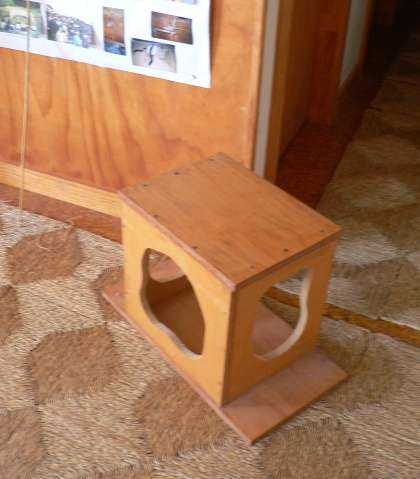
Fig.3-3-1 Two foot steps. They got cuts when I got a jigsaw.
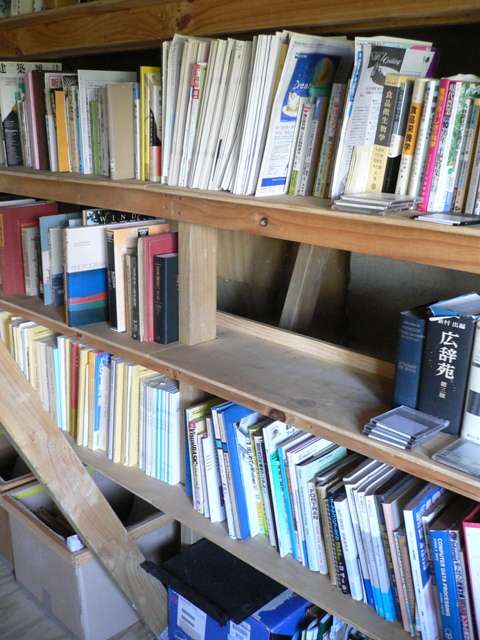
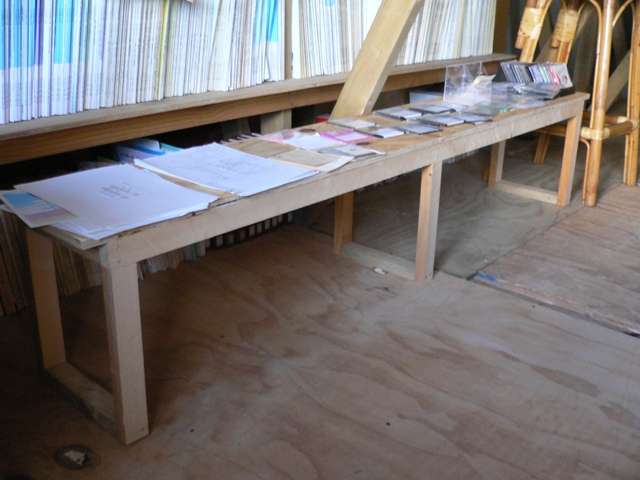
Fig.3-3-2 Book shelves in the study and the bed room
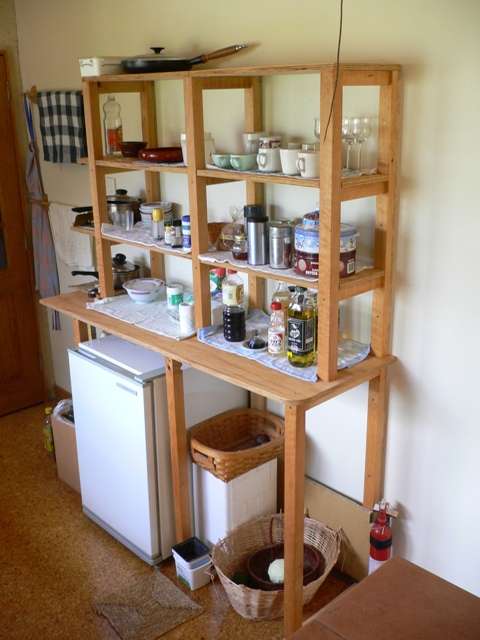
Fig.3-3-3 Cup board
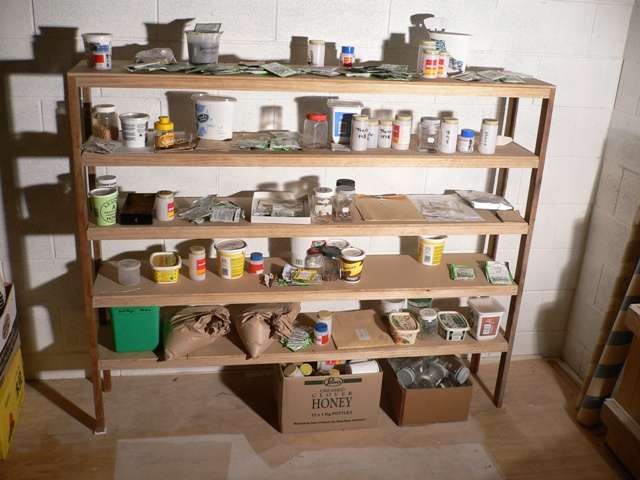
Fig.3-3-4 Shelves for seed banking
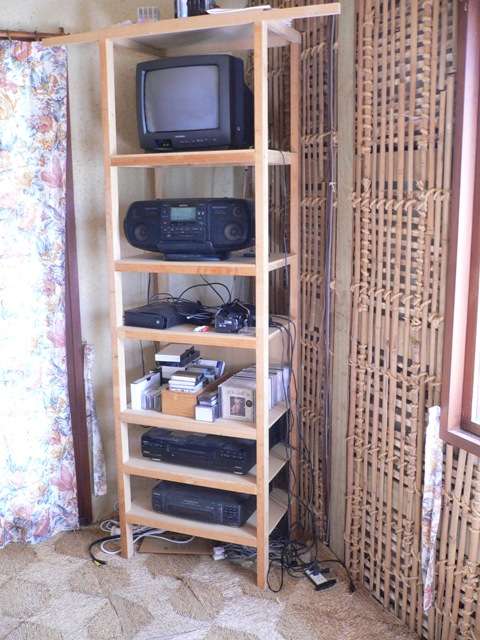
Fig.3-3-5 Shelves for electrical machines
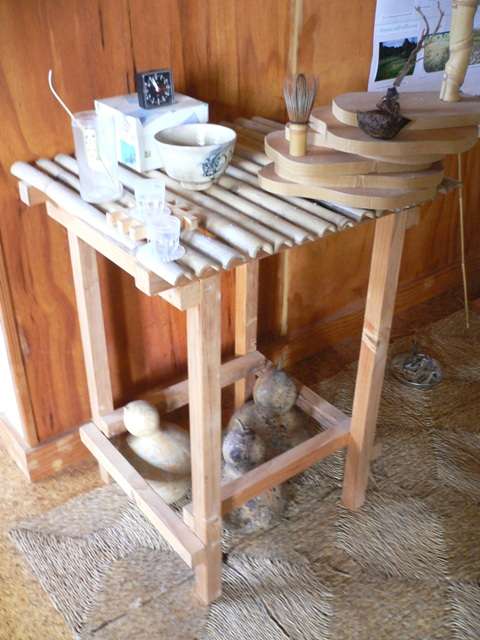
Fig.3-3-6 Telephone rack
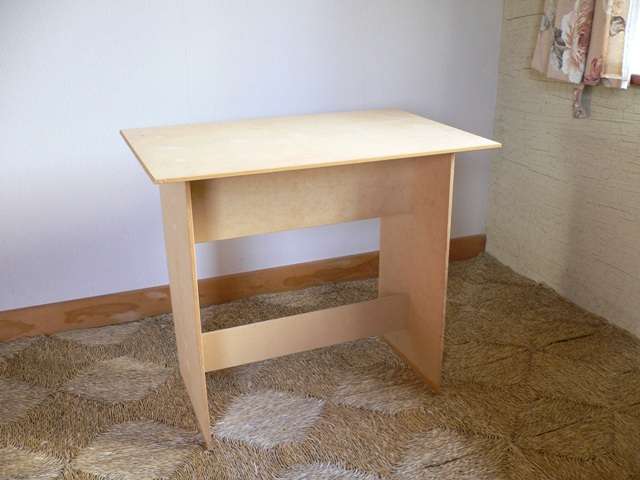
Fig.3-3-7 Little table
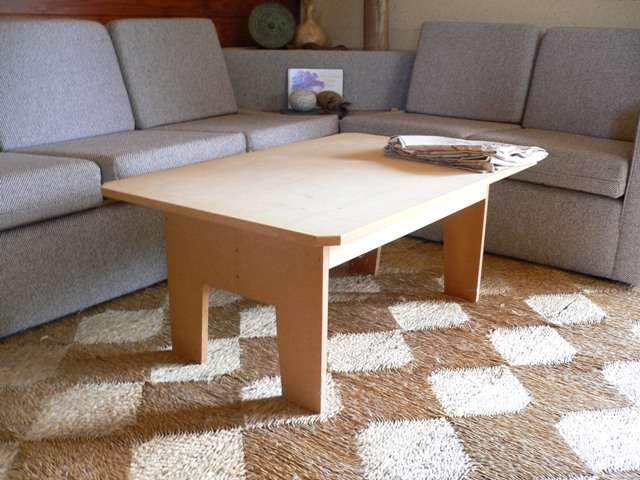
Fig.3-3-8 Sofa table
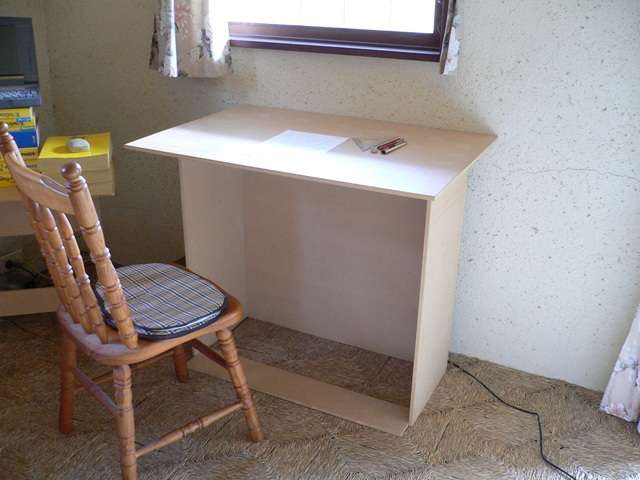
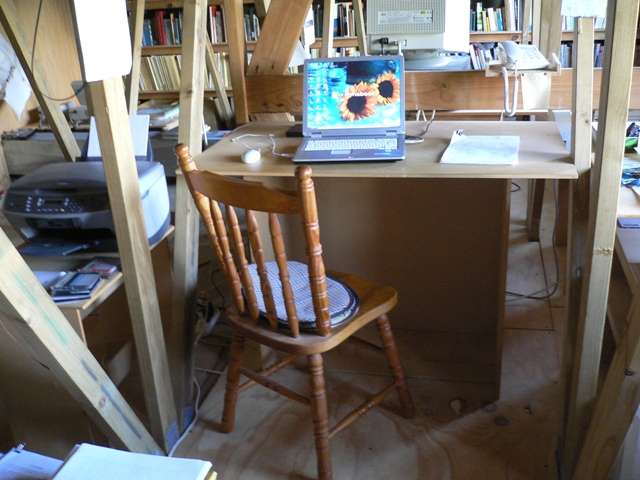
Fig.3-3-9 Desks
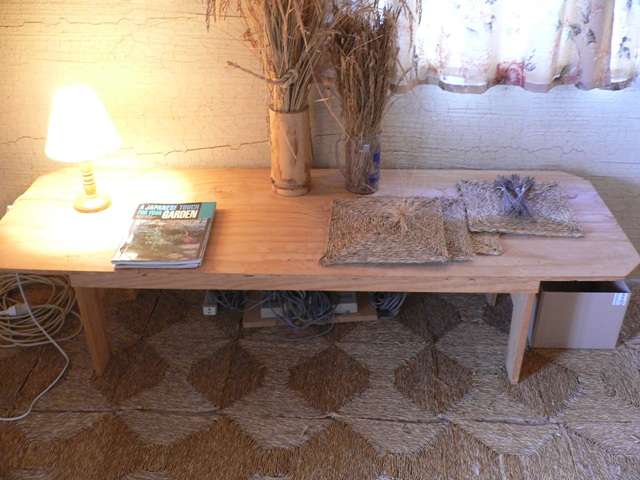
Fig.3-3-10 Japanese table
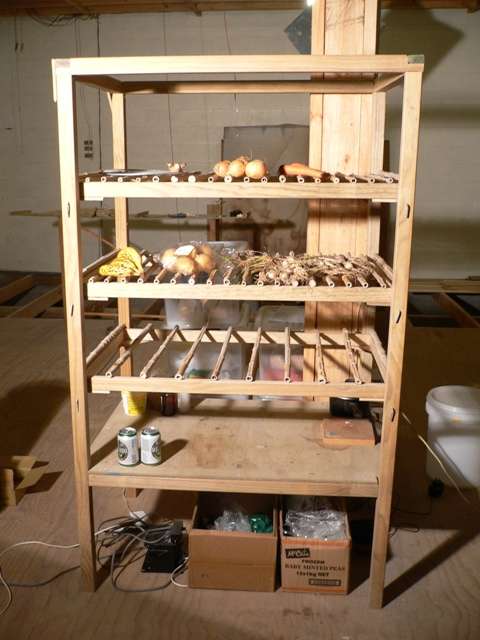
Fig.3-3-11 Food store rack in the basement
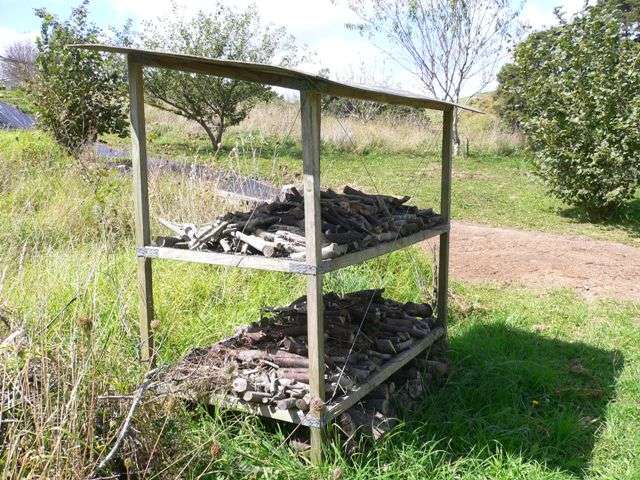
Fig.3-3-12 Drying shelves for Kikuyu grass
Fig.3-3-13 Stool for
the fireplace in the shed (Picture not added)
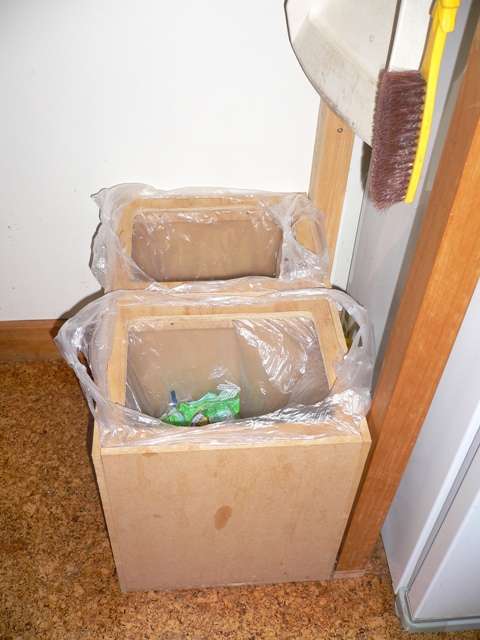
Fig.3-3-13 Trash cans
3-2) Joy to express inspiration with surrounding miscellany
A monotonous wall needs anything like, paintings, ornaments etc. A
corner spot where three straight lines gather needs anything too. If we
buy them they are expensive. However, we can replace with things around
and/or given by friends to create something with them.
If a part of them is changed, they give us different impression each
time. Though I don't want to be argumentative, the space gets the time
domain. It is a little joy which is given by a change. And, if we feel
our own joy with them, it is the point.
Fig.3-3-14 A jump
The guy in the right top thinks that he is out of the structured
society that is expressed by the bamboo table frame to feel
enlightened. However, if it is observed from a side, he is still in the
continuation from the society.
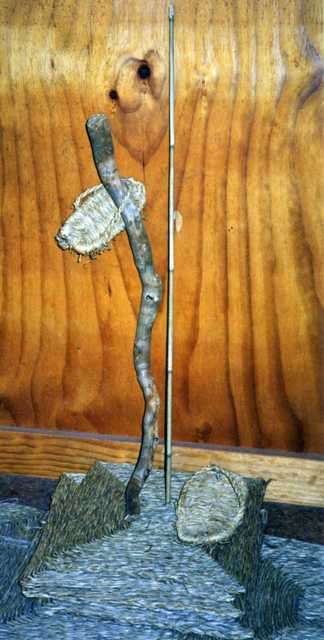
Fig.3-3-15 Start for a trip.
A father and his boy prepare for their trip with grass sandals and
sticks.
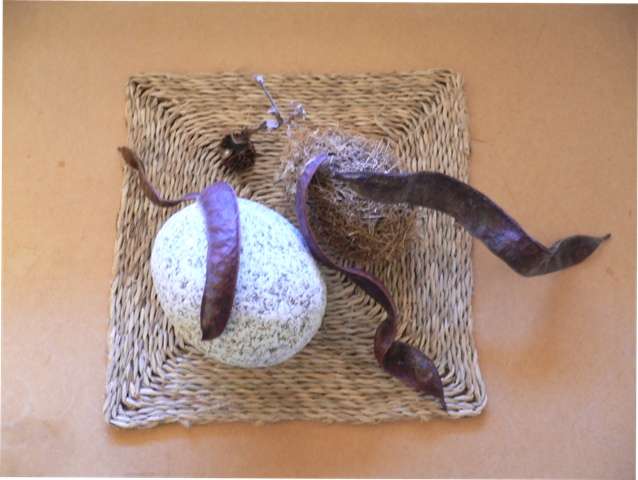
Fig.3-3-16 Nosy
Honey loquat seeds are nosy at strange looking things, just like our
society is.
3-3) Joy from four seasonal changes
Nature pleases and delights us with the beauty of every four seasons.
Although I never tried to plant flowers, every corner of the veggie
gardens, in the rice paddy, we can find wonderful arts with flowers of
fruit trees, those of usual trees, new buds if we strain our eyes. I
could not spend enough time to record them. I want to keep them for the
next time. Here, I show a part of them.
Fig.3-3-17 Spider web
formation (Not given yet).
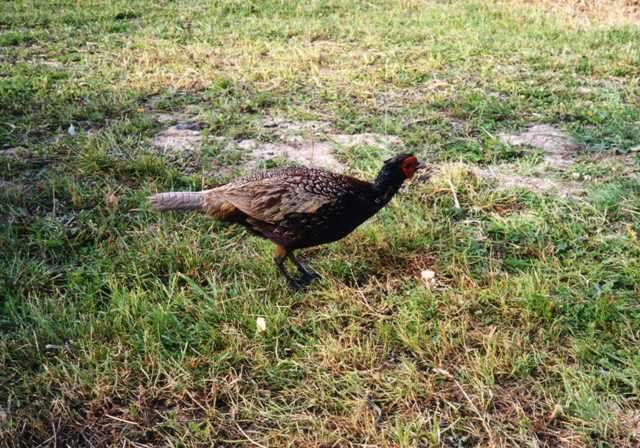 |
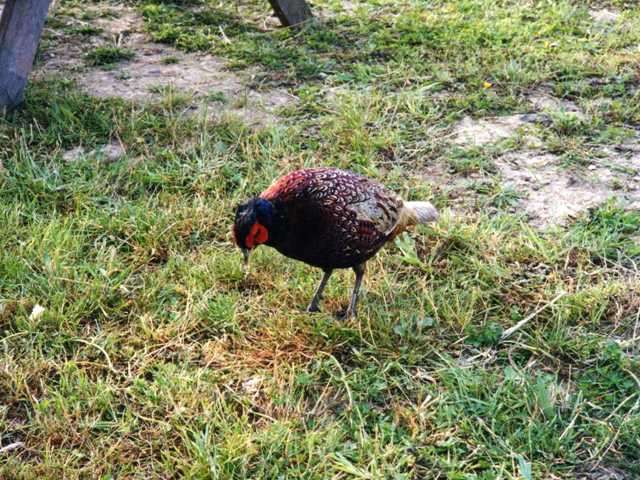 |
| a pheasant Kome |
a pheasant Kome |
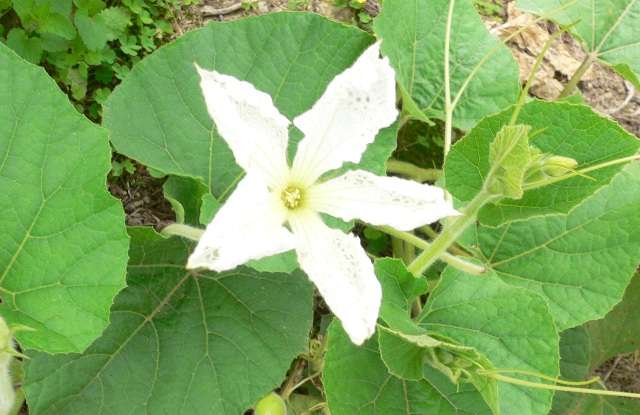 |
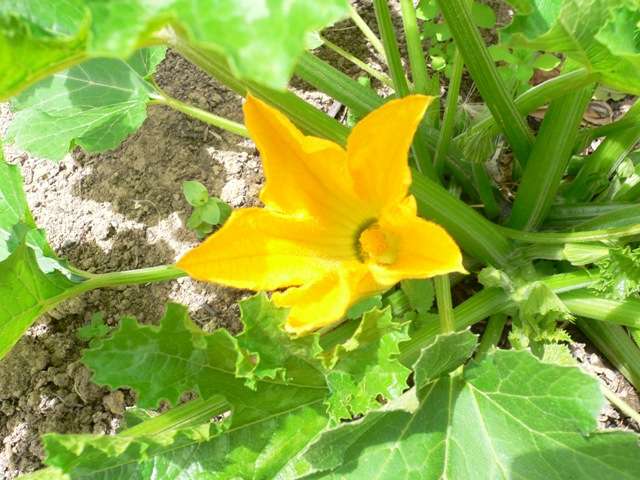 |
| gourd |
Zucchini |
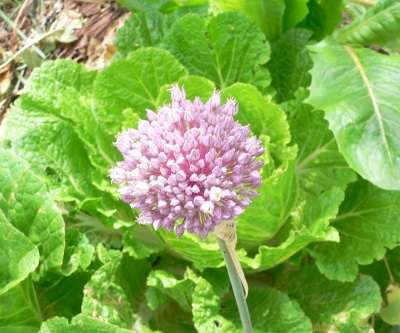 |
|
| garlic |
|
Fig.3-3-18 Two shots of a
pheasant Kome Flowers of veggies Zucchini, garlic and gourd
I started to raise a sheep on the 20th of October, 2003. He was brought
with his name Tintin. When he came over, he still needed milk and after
some while he ate only grass and became bigger day by day. His
cooperation was valuable, he weeded, and his dung was given to the
septic tank and a compost box. His sheared wool which was expected for
cloths. Unfortunately, he died on the 20th of June, 2004 while I went
back to Japan.
When he got facial eczema, his liver suffered. Later, he lost his back
hair 3 to 5cm wide and winter coldness went into him from there. He
must have missed me. It was only 8 months but I enjoyed living with
him. Every morning I took him around to find new grass. He taught me
the importance to have a contact with animals. Thanks, Tintin.
Shorn Tintin with Japanese
drummers (Picture missing)
Creatures coming around are many:
Animals: hedgehog, ferret, rabbit, mouse, rat etc.
In my neighborhoods: sheep, cow, horse, goat, cat, emu, deer, chicken
etc.
Birds: pukeko, starling, blackbird, thrush, tui, rosera, fantail,
kingfisher, robin, yellow head, swallow, minor, sparrow, wood pigeon,
silver eye, Canadian duck, pheasant, hawk, duck, turkey, peacock etc.
In the pond: frog, eel.
In the rice paddy: frog, dragonfly etc.
They give us natural environments, but we have to be careful about some
of them. Pukekos, sparrows, rabbits etc damage our crops.I protect my
rice with a 1.9m tall bird net over the paddy, 45cm tall chicken wire
fence around the veggie garden. I see many cicadas, but they are not
that welcomed by us.
3-4) Memories of autumn music gatherings at the hand-made amphitheater
Among our Acoustics researches, there is a paper where we found that a
wave reflected at the grazing angle over a porous material surface
produces a negative wave (see Fig.7 on p.131 of the paper referred in
the end of this paragraph). In a usual concert hall where seats are
gently raked, this phenomenon occurs at the reflection from the front
seats and it decreases the loudness of the direct sound from the stage.
Then it has to be reinforced with the reflections of the boundaries
like the ceiling and lateral walls.
On the other hand, if we go to a Greek amphitheatre, we are surprised
with its steep slope and the clear strong direct sound from the stage.
The angle of the audience slope has 26.3deg which was measured by Prof.
Meyer at Berlin Technological College.
It gives less of a negative reflection, has more delayed time from the
direct sound, and it is heard clearly at any seats. It is interesting
to know how they found the phenomena. It will be guessed a bit later.
If a stage is flat and does not have anything, it sounds as if in the
field and the sound does not travel aloud and a performer there has a
difficulty to play. The rectangular enclosure was made on the stage
expecting its clear resonance frequencies support performers. Namely, a
natural musical instrument was installed.
It is a brief acoustical explanation for the amphitheatre, but the
interesting subjects are remaining, e.g. which dimensions are the best
for the enclosure, if it gets a ceiling the density of resonance
frequencies will be thicker and how it affects a performance, the
comparison between hearing impression and an impulse response at the
audience and so on.
Although it started with the acoustical interest in such a way, an
amphitheatre offers performances on the stage with the surrounding
atmosphere. We started to have music gatherings in the greens and/or
under the stars.
Having a similar angle of slope at the hill, it was not exactly
26.3deg. Any machines were not able to use to have steps with a little
curvature learning from a Greek amphitheatre. It was only by hands.
Under the strong summer sun many people helped us and after days we got
a hand made amphitheatre to accept about 250 people.
In the meantime, an interesting observation was obtained. When we moved
the soil on the hill to the slope, the clayish soil made a cliff with
release. Such a time, we ordered river sand and it was chucked from a
dump car on the hill. I noticed that the slope of the sand cone made
almost 30deg to the ground line. At this stage I guess that the
empirical slope was obtained when they talked along a sandy slope up
and down, they could hear each other well. The country must have sandy
soil.
At a music gathering we leave every day's life, find joyful moment and
space which are created between performers and audiences, and meditate
towards the natural space. Greens, stars and music would be a rich
moment. We need not to use the place only for the acoustical purpose.
It is said that music started for praying to God. The chanting choir of
Tendai-shu Buddhism was invited to the international religions meeting
at Praha in 2000. When they were practicing, another chanting group of
Catholic Gregorian proposed a joint chanting. They did a joint practice
spontaneously, and performed in front of the participants of the
meeting. They impressed so deeply to the audiences. Music must have
something beyond religions.
Finally, having the acoustical research purpose we got the first music
gathering on March 30, 1996. We guided the experimental house as well.
Our music gathering started to happen once a year to pray for good
harvests and appreciate them from God.
The first one and the second got four years blank. We got the tenth on
March 8, 2008.
Here I want to look back them with my diary and opening
speeches.
Y. Sakurai: “The early reflections of the impulse response in
an auditorium", J.Acoust.Soc.Jpn. (E), 8, 4(1987).
Y. Sakurai and et al: “Reflection of sound at grazing angles
by auditorium seats", Applied Acoustics, p209-227, 39(1993).
(i) First music gathering on March 30(Sat), 1996
When we got up at 8 o'clock, it was fine with blue sky. We started to
work all together. A tent was installed in front of the kitchen. A
table was being assembled with plywood. National flags were tied on the
wind mill posts. NZ, Japan and Switzerland from left to right following
the protocol. Two platforms were given in the middle of the stage to
put in a piano. Tea and coffee were prepared.
A Japanese group arrived first just before 11am. Successively Othmar
brought in an electrical piano. People arrived in about twenty cars.
They tried to adjust the piano, but something was wrong. A pedal
doesn’t work well? Is power supplied? Connectors are wrong?
They
found a misconnection of plugs and then it started to sound like a
piano. When today’s pianist Nichole Nulden asked me for an
umbrella to shade her as she performed, I felt embarrassed. Fortunately
the sun was hidden behind the clouds. It turned out to be the perfect
weather for the amphitheatre performance.
Finally the assembly started 30minutes behind the scheduled time of
11am. Heidi gave the first opening speech: the German and Japanese
choirs in AKL are making their friendship deeper after they had a joint
participation to support the Beethoven’s ninth choir of the
handicapped people’s choir "Yukiwariso" from Tokyo. A brief
explanation of the project and team members was given and she passed me
to talk about the project.
I have talked a few times about the project and thought I would get
used to it, but I got nervous in the beginning and finished the outline
explanation. Namely, the four purposes: the solar energy use,
nature-friendly materials use, no contamination and self-sufficiency.
In addition, computer programming, acoustics research of the
amphitheatre etc were mentioned introducing involved people, our
plumber Bruce, an odd job helper Paul, George for an acoustic
measurement.
Before we started a tour, I mentioned the location of toilets, careful
and responsible deeds, and the later schedule. I explained the outside,
Heidi did the ground level, and Paul did the basement. The solar room
was planned to be done by my student Hiro, but it is too narrow to
accept many people and so we left it out. The tour was in such a way to
have them split and successively, but it happened to do spontaneously.
Hiro explained the solar cooker and the solar oven. Bruce did the three
ponds in the green house. Akira did video-taping.
Each one opened one's lunch on the hill. We thought to have a light
lunch, but Lisa invited me to her Japanese group. They offered me a lot
of Japanese dishes. Even Kiwi Bruce accepted some. About 12 Japanese
people made a group for lunch. I hoped to be with other nation people.
Next time I’m sure they will be used to being internationally
social.
While no people were at the amphitheatre for lunch, George tried to do
a measurement at the empty audience. Unfortunately people slowly
returned and it was postponed for next time. George's recording system
does not have a long enough cable for a simultaneous measurement with
two microphones, i.e. it gives a difficulty to separate the direct
sound from a received sound at the audience.
The music gathering was started at 1:30pm. Our neighbors came along.
Hiro counted 62 people in the morning and there were more than 70 for
the music gathering. Othmar chaired the program. First we sang the
national anthem all together.
Choruses by the Japanese and German choirs for their own country's and
joint ones followed, Nichole played the piano in between. Othmar's
humorous speeches cheered the audience. He praised that this is the
only amphitheatre in NZ and that the enclosure of reflectors helps
performers on the stage, without it a performer would have felt to sing
in a field. I agree with him on the effect of it. The sound on stage
was developed in the space especially since it was made rectangular.
Performers said they felt enveloped. If it will get ivy on its inside
surface, the sound there will be more distributed and singers and
players will appreciate it. Nichole did not say that anything was
wrong. A chorus must be done gathering near the conductor to make a
point source on the stage as Dora said later too. I moved around while
they performed. Middle stands could be the best area because the sound
was heard with good harmony and they got good scenery beyond.
The first music gathering finished wonderfully. Each choir was nervous
on the stage, but it made their performances more cheerful. Nichole's
piano play was excellent indeed. She played with confidence putting in
her studied expression. We enjoyed her plays with sureness. They will
remain in our hearts for a long time.
We enjoyed an afternoon tea finishing the music gathering. I enjoyed
talking with them drinking beer. They enjoyed it too with Swiss cake
and coffee. They left by twos and threes. The weather was just ideal
for us and for the amphitheatre performances. I appreciated the
Teruteru-bozu doll, a fine day boy. Their plays were wonderful and
acoustics of the theatre was good.I had nothing to say. Some day I want
to have it under the star lit night. I just appreciate God.
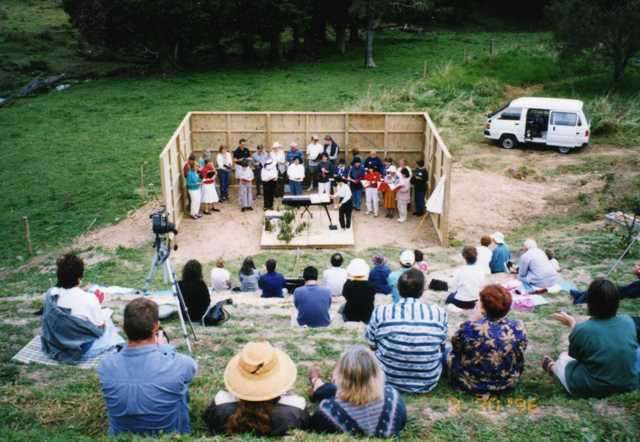
Fig.3-4-1 Joint performance of the Japanese and German choirs
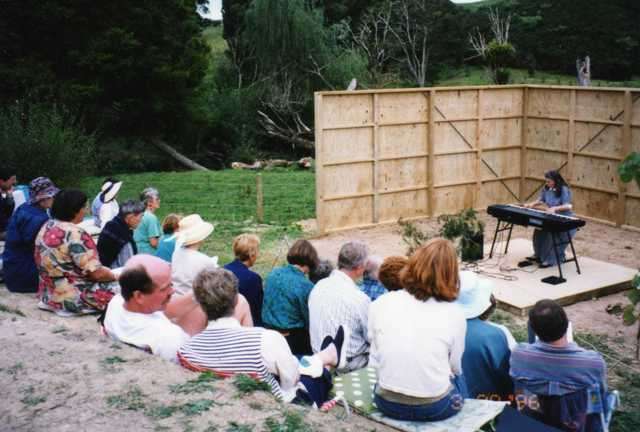
Fig.3-4-2 Nichole plays Brahms.
(ii) Second music gathering on March 25, Sat, 2000
At last, a music gathering under the starry sky was realized after a
few years break.
I got up before 9 o'clock. Norbert had already started to work the
candle stands at the stage after having finished his thatch roof
renovation. Grant also started the preparation of Acoustic measurement.
Rob turned up earlier than usual for mowing. Candle stands were nailed
on the reflector panels on the stage.
When Rob and I were standing a sign for "Experimental House", the first
comer Ewan turned up. Othmar told to German choir members to come
earlier, he said.
German choir members arrived one after another. Setsuko and Othmar
brought Michiko. In the meantime Grant and I did a preparation of
acoustic measurements. Around five o'clock Aucklanders started supper
and we three were invited to Setsuko's table. After that 12 to 13
people were split to two groups and we made a tour for the experimental
house. I am pleased that many of them were interested in the project.
The choirs started warming up before 7pm. We had to give up an
acoustical measurement unfortunately, because we found the power supply
was broken.
Neighbors turned up gradually and they were more than 80 people at the
beginning. I read my opening speech which I wrote beforehand. Trees
were lit up. When a light was moved, they responded to the change.
We played a tape of waves which was recorded by Grant at Hatfield
Beach, and the sound spectrum proportional to 1/f is heard very natural
and relaxed. A music which was chosen with the spectrum was played and
it was good for meditation.
It was explained that the purpose of the amphitheatre was for an
acoustical research, I told them that we had to give up the day's
measurement because of the trouble on one of the instruments. I played
a tape of a Japanese Buddhism chanting showing that music was started
for a prayer to God.
Now, it was handed to Othmar. He introduced the German choir. We sang
Pokarekareana all together and the choir got off the stage.
The Austrian singers sang four yodels. The last one got an encore
finishing the whole program.
It was a wonderful fine day. We had the Milky Way just above us which
included the Southern Cross. The scenario was just as I expected at the
last music gathering. After the music I showed my rice paddy with a
torch and we got back to the hill top.
We enjoyed drinking wine. Oops I might have forgotten to prepare the
cups. However, everybody must have enjoyed it. Bev came along saying
that she did not have enough time to play tennis with me and introduced
me to two charming ladies. Many were from Kaiwaka. Last time there were
approximately 70 people here but this time there were more than 80. The
following is the manuscript for today's opening speech.
A night for sound and light
Among all the creatures on earth only human beings cannot live
sustainable because of their greed and arrogance. For us the present
human beings, it is evident that we have to live sustainable. It is not
said only because of the global warming and the energy crisis.
Where our souls go and how do they go? It does not look to be
discontinuous even if a situation is different. When the solution of
this interesting subject is found, our souls will be liberated.
However, it will need enormous time to solve it. The sun and the earth
will die whether or not. We may need the time until the last moment.
For that we have to love our precious earth and keep it.
To find a peaceful soul world we need a joy given by nature. It is one
of the items on the sustainable project to find it in nature. It is
true as a German saying that a joy is an impulse from God. It is also
said that it does not need much to get a joy, but if you get it, you
feel like a king or a queen. Let's enjoy tonight together.
Non-linear and non-reproduction
How often I have enjoyed beautiful sunsets and sunrises since I came to
Kaiwaka. As they are physically the interaction between the sun and the
clouds, they seem to us to be arts given by God. They probably have the
expression that we can not create. The clouds are caused by the
turbulence of air flow, and our scientist says it is non-linear. It
means that it is non-reproducible.
Tonight we want to try to express a similar atmosphere using wonderful
trees along the front creek. Can't we create continuity from the
artificial light fantasy to the star lights in the universe? John
Whelan, my front neighbor, helped me to set up the lights.
-Light up of trees-
First I wanted children to play in the light under trees, but the
lights are too strong for their eyes and I gave up.
The wind changes lights and each one feels differently their
impression. The freak of trees and the breeze. Such a wonderful
phenomena can be seen anywhere in nature. It is the entrance to a joy,
yes, it is a joy itself.
A phenomenon of disorder or non-reproduction seems to have a deep
secret. A sound of waves is acoustically a noise. But it is not the one
that annoys us. An acoustician explains this, we have the biological
rhythm in our self that has a frequency spectrum inversely proportional
to frequency f (Hz) and any sound of the spectrum does not annoy us.
Tonight let's listen to a tape of waves recorded at Hatfield Beach by
Grant who is a young Acoustician to get a PhD at AKL Univ.
(We planned to record the murmur of a stream, the whisper of leaves in
the breeze, the sound in a long pipe with air turbulence, the sound of
rain etc. But we could not find enough time.)
The play with nature is really pleasant and delightful. It hides the
origin of arts, I think.
-Sound performance-
Music gathering
It is said that music started from the prayer to God. Each tribe
brought up its own heritage. After these five lines, i.e. a musical
note, were introduced, the musical expression became common and enjoyed
through the world keeping its own locality. At a live music performance
we hear it with a then feeling, the situation has no reproduction.
Now we turn the artificial lights off, spreading our minds to the
unlimited wonderful space of stars, we listen to music.
We got a lot of people from AKL too. I hand to Othmar to chair the
program.
After the program, I took them to my rice paddy.
-Appreciation to the harvest of rice-
We have another stage for tonight. Rice is a fundamental food for
Asians not only for the Japanese. We have sent our appreciation for a
good harvest to nature and we had a festival on the autumn equinox
respecting our ancestors. It is one of good thoughts to find a
contacting point to nature.
I hope that rice brought in Japan grows here at Kaiwaka and that it
will be succeeded to the following generations.
There exists the origin of arts in nature itself, and there exists
creation and arts in oneself. When they are brought together with
respects, finally, it would be possible to jump into the next plane of
the soul world, I think.
Arts must admire nature with love, and we imagine God through them.
They are the method to develop appreciation and admiration to it
through meditation. Namely, arts must be expression to be with nature
and in nature.
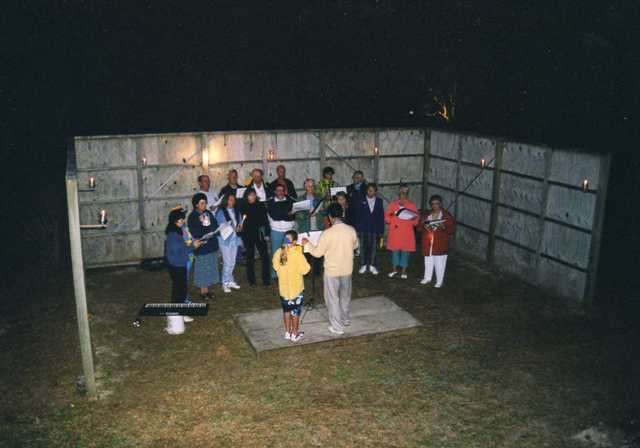
Fig.3-4-3 A girl helps the German choir conductor giving a light.
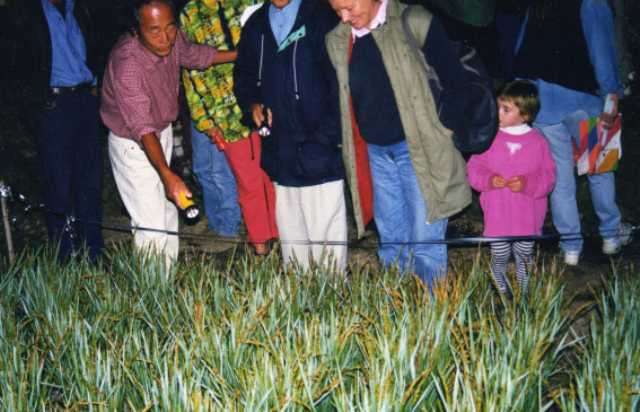
Fig.3-4-4 Yoshi shows his rice paddy with a torch.
(iii) Third music gathering on March 24, Sat, 2001
I got up before 9am. When I was fixing a light stand for the paddy, my
neighbor children, Glen and Leeza came over. She helped me to arrange
some harvests on a showing bamboo table. Bruce turned up but he left
soon saying he will come back for the music.
Following them, Brenda, Eli, Wady, and Paul arrived. Paul worked for
the indicators. Tatjana gave me a phone call to come and help at 3:30.
Grant, Lars and I did an Acoustical measurement for the vacant
condition. It finished at 5pm.
Choir members arrived by twos and threes. It started at 5pm. It was
fine and we appreciated God. At my opening speech I explained
especially about today's Buddhism chanting. Changing the original
program, we did Acoustical measurement first when the auditorium was
filled with people. The sound generating system did not work well, but
we could have five good shots. The start was delayed by 30 minutes.
The first program was monk's chanting. The unison of seven monks'
natural voices was powerful and delicate. They were unison, and only a
few times harmonized and got beat, I felt. Their costumes produced
wonderful atmosphere as well. Their entrance and exit gave us a special
impression too.
German choir and Austrian singers followed. And then we had
intermission.
When dusk came, candle lights were turned on and we got a different
atmosphere. I got an explanation for the next chanting from Mr.
Saikawa, my family monk beforehand: it is for calling God at the first
half when colorful flower pedals are spread into air, they are
appreciating God for being together, and finally they send God back to
the heaven. With the atmosphere given by the candle lights, a bit
cloudy but with stars, and the light up of front trees and the rice
paddy, a chanting was started in such surroundings. The audience was
decreased to 60 people, but they listened to it enthusiastically.The
German choir and Austrian singers were much better than last time.
Finally the music gathering was over.
At the mutual talking in the end, many talked with monks. In my next
Othmar sang a song to cheer people. I thought it was a good idea and I
joined too. But I was regretful that I sang too loud. I was so drunk
and I don't know who did the care for thing left, but what I remember
was that around 10pm Grant, Betty and I went to the Town Hall to see an
Irish Dance Party.
I did my opening speech as follows.
"Choirs for Harmony and Unison"
Welcome to our amphitheatre today.
It is true that time flies like an arrow. Once again autumn has come,
time for harvesting, since our last musical gathering. I hope that your
harvest is also satisfactory and or towards a good harvest. The time
around autumn equinox is a time for appreciating Nature and Providence,
having festivals. In Japan, we celebrate autumn equinox with a simple
arrangement of grasses, surrounding this with harvest produce and
goodies for kids on the night of the full moon. I have placed such an
arrangement near the rice paddy using toitoi as the grass.
Two years ago, my mother passed away. I was not in time for the
funeral, but in time for the next important prayer on the forty-ninth
day after her death. In our Buddhism, a soul needs seven weeks to reach
heaven, having a more heavenly name every week. Our family priest, Mr.
Saikawa, chanted wonderfully for my mother on the day. I know his
father and he chants well too. I asked Mr. Saikawa if such chanting
could be performed in front of people to admire and enjoy. I learnt
then that they started a chanting choir 15 years ago with 11 members.
This choir was invited to the opening concert of the new Kyoto City
Hall that was built to commemorate the 1200th anniversary of the city.
Later, this choir was invited overseas, to Norway, Sweden, Belgium,
France, Czechoslovakia, and so on. Religions in the world held an
international conference at Praha in the year 2000 to increase
understanding of each other and break through barriers between them.
The chanting choir was also invited to the conference. During
practices, the Catholic Gregorian Choir proposed that they sing
together. They never had any joint practices before, but, interestingly
enough, it melted together so well on the stage that the audience was
deeply impressed. Mr. Saikawa told me about it on the New Year day card
this year.Finally, we have them here tonight at the Experimental House
in Kaiwaka with the German choir and Austrian singers from AKL.
It is said that singing started as an earnest and fervent prayer to
God. The choir chants in the unison of men’s natural voices.
Besides, they follow the old musical note that is different from the
staff (five lines) note. They still keep the original note to chant
that originated in Gyozan Mountain, China in the second century.
When listening to the chanting, you may or may not expect such
stimulation in your feeling that you get from western music. People who
are familiar with European culture, be reminded of Gregorian chanting
in a Catholic church.
Tonight’s chanting is divided in two parts. In the first
part,
look towards the trees and plants, and spread your feeling to the
clouds and the blue sky, then feel the universe beyond. In the second
part, hopefully under the star light, spread your mind to the universe.
It might be important to think of our-selves as a tiny existence in the
universe away from the daily work.
If you breathe with your stomach and concentrate your mind to the
breathing only without thinking about anything else, it might help to
take you into meditation.
This is the third time the German Choir and Austrian Singers perform
here and they have never asked for any money. Japanese priests paid the
main expenditures including the air fares by themselves. We are very
fortunate and appreciate their love and compassion.
Today’s program starts with the Japanese Buddhist Choir
chanting
‘taizoukai mandara kuonyo(胎蔵界曼陀羅供音用)’ Prayer for
the
universe and God. Then the German Choir and Austrian singers will sing
for us. After that we would like to make some acoustical measurement.
We can then have a stretch at intermission for a quarter of an hour.
Wine or drinks will be served on the hill. Please mark your cup for
later use.
The second part of the chanting starts around dusk and then songs by
German Choir and Austrian singers.
At the acoustical measurement
This open theater was constructed for Acoustic research purposes. The
slope of the stands has about 26degrees as in the Greek amphitheaters.
You can hear the direct sound from the stage without the large negative
reflection in front that occurs with the gentle slope of an auditorium.
In addition, the stage has a rectangular enclosure to support
performance.
Now let us do some acoustical measurement at this opportunity. We need
a quiet moment after every explosion. Please put your fingers to your
ears. We will have ten explosions tonight. Please cooperate with us.
These days I believe that not only our individual differences but also
the cultural differences give us spiritual energy, inspiration, even a
new direction of thought. Since we started our project here, Kaiwaka
shows good examples of this here and there. I hope that it will keep
going well and create something new.
Tonight in the Kaiwaka Hall is Celtic dancing which starts at 7:30 and
goes until 11o’clock, as long as I know. You can also
exchange
culture, surrounding tables with prepared free drinks and snacks.
Before everybody leaves the theatre I would like to take this
opportunity to say thank you very much to the German choir, the
Austrian singers and the Japanese Buddhist Chanting Choir for coming
along and performing for us tonight. I would like to thank many
neighbors and friends who helped in preparation for today, and finally
thank you all for coming.
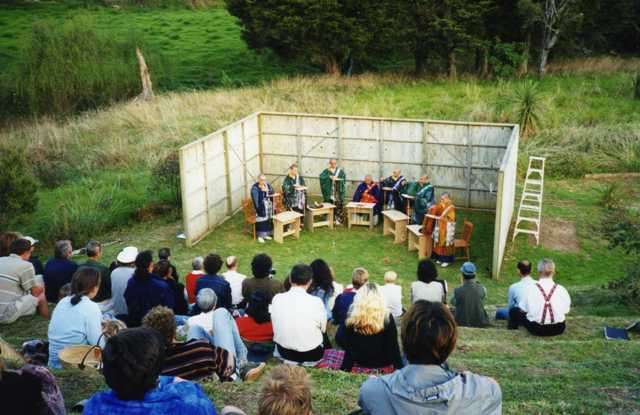
Fig.3-4-5 Chanting by seven monks of the Tendai-shu Gyozan-shomyo
Kenkyukai
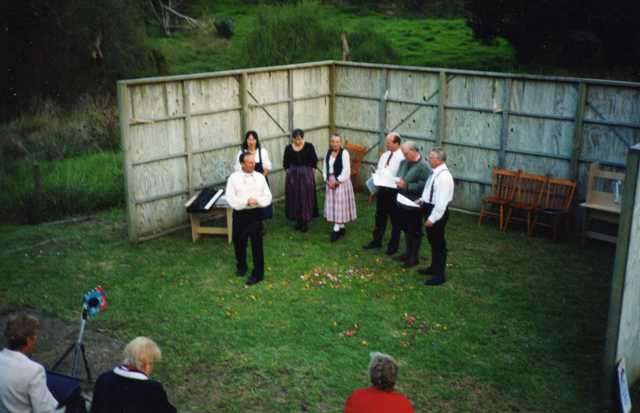
Fig.3-4-6 Austrian singers
(iv) Fourth Music Gathering on March 30, Sat, 2002
I got up at 10am. Cutting weeds in the paddy, mending the bamboo fence,
cutting the grass on the right side steps of the amphitheatre, Rob
turned up. My first exchange helper Mayumi got up earlier and went
shopping. She did my hair cut too.
Around 3pm, Brenda came over with her children. They started to prepare
snacks. Wady helped Rob put up signs. Lars arrived to work to wire the
power lines. I helped him until we fixed a stand for the rice paddy
lighting. Othmar turned up and we talked about today's program. Setsuko
listened to my singing of Shiretoko in the basement which has a good
reverberant sound field, and suggested me to make a good succession of
high tone near the end of the song.
We got a rainy weather forecast and I started my opening speech at 5pm.
Austrian singers were behind schedule, but I used it for requesting any
performers for today to fill the sudden change of the program. Gunter
accepted it. Finally, the program started with their choir.
I finished my comic storytelling, Rakugo for 'Tokisoba'. It wasn't that
bad, because they laughed a lot. David Yu and Jane Zu successively sang
and they did a duet afterward. It gave us a different atmosphere and
made us joyful. Jane sang Italian arias, but the accompanied music on
tape was too loud and suppressed her wonderful voice unfortunately.
Because of a bit of rain threatening Othmar started a bit earlier on
the second part shortening the intermission. I sang Siretoko, then
Othmar, setsuko, and a Korean woman sang Sakura and Hurusato
successively. Jane sang Chinese songs which I quite liked. She got
musical education in Shanghai. David did a solo. I felt the musical
level of China is very high as expected.
Gunter from Germany volunteered a song nicely. Chen from China sang a
local song with a lovely local flavor. We enjoyed the full results
created by the gathering of people excellently the music gathering was
over. A scheduled program had to be changed because of a sudden
performer's absence and it was a bit embarrassing. However, volunteers
covered up.
Fortunately, we didn't have rain, we enjoyed atmospheres created by
people's gathering, and I felt wonderful.
Opening speech
I think that a change and a difference give us a great creative energy.
The change by every season is an example for the former and a different
culture, namely, the difference gives us a great impact.
It is wonderful to meet again on an autumn day of harvest time after
one year separation and to have new comers. I want to appreciate the
nature and God with you. Though we can not have a regular member of the
German choir, Austrian singers have successively come along. An
expected Russian tenor could not come. However, Taiwanese and Chinese
singers are here. I met a Taiwanese tenor David when he was building a
musical chamber and asked me if anything wrong acoustically. He now has
a wonderful hall in AKL.
The ring of people beyond nations is developing here at Kaiwaka. It
might have done by God consciously.
Please enjoy music in the surrounding atmosphere from bright day time
to dark night time. When the darkness slowly comes, we will have an
intermission for three quarters of an hour. Wine and snacks will be
served.
In the meantime you can go to the rice paddy, though you have to be
careful for wires and birds net.
Using this opportunity, I want to thank Rob Sampson for his mowing,
Paul & Brenda Jackson for preparing the snacks and setting up,
Lars
Haakenberg Van Gaasbeek for his wiring lines, and my exchange helper
Mayumi for doing odd jobs.
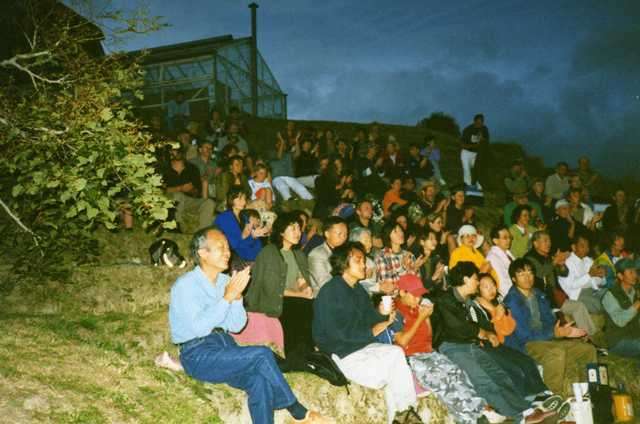
Fig.3-4-7 Audience in the beginning of the second part
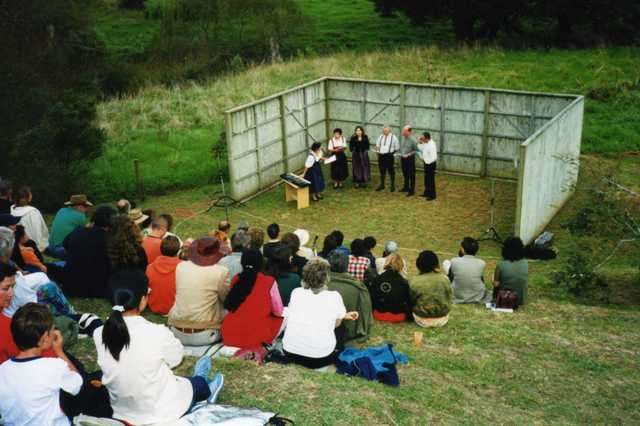
Fig.3-4-8 Familiar Austrian singers
(v) Fifth music gathering on March 15, Sat, 2003
Up at 8am. We started the last preparation for today's music gathering.
Rob came over for mowing around 12 o'clock. He did around and in the
amphitheatre, the way to the theatre, the car park, the entrance to the
house, etc. By the time he had finished everything it was 4pm.
Lars came for the wiring which was separated into two groups: one for
the stage and the recording system, and another for lighting up trees.
Paola delivered 12 breads, 6 casks of red wine, 4 casks of white wine
just when Lars came.
Around 3pm, the Japanese drummers turned up driving through from
Palmerston North. Haruo and Chiyoko came with organic tomatoes. I asked
them to direct the kitchen work and went out to keep preparing. People
started to come by twos and threes. The electric piano did not work
well and we decided to use a key board for the replacement. George and
Marion, his son Andrew and his girlfriend came too. I briefly explained
my project taking Andrew and his girlfriend into the house. Sarah
turned up too.
Because of the electric piano trouble the opening speech started at
5:30. The German choir returned. Newly we got Japanese drummers. The KW
local band arrived a bit late. Very pleasing was that we got
mezzo-soprano soloist Yuko and her husband Farrell. His bamboo flute
was wonderful. Yuko's Japanese folk songs were excellent. Japanese
drummers showed wonderful performances which were very rhythmical and
never monotonous as I imagined. Every year we get more performers as
well as audiences. Detail must be seen on a video tape.
Various performers on the stage, each one's character matched so well
on the stage in nature. The harmony between audiences and the stage was
wonderful too. I affirm that this year we got much better. I talked
with many people and all of them admired it.
I must not forget to send photos to Herbert. Nishimura helped very much
with consideration. He cleared the place too. It was cloudy with a few
drizzles in the morning, but no drops of rain at the music gathering.
Very very lucky.
Opening Speech
We have again come to autumn for harvest. I am glad to see you again at
the music gathering after one year. I see some people have come here
for the first time. We welcome all of you.
First of all, I have to explain about toilets, especially for new
comers. One is a long drop near the car park and another is in the
house. You will see a curtain if you enter through the porch. It is in
the right hand side. Please take off your shoes before you enter the
porch. Women have the priority to use them and men can do everywhere in
the field.
Last year an expected person did not turn up suddenly and some people
covered it. They also entertained us wonderfully with each one's
expression. We can continue today to enjoy with the same theme, the
variety of performer's expression and creation. The program for today
will be:
First part
1. Austrian singers
2. Chinese and Taiwanese singers
3. Irish whistle
4. German choir
5. Japanese female trio
6. Irish and Scottish music with local band
7. Japanese drum
Intermission
Second part
8. Duet
9. Bamboo flute
10. Irish and Scottish music with local band
11. Piano solo
12. Chinese and Taiwanese singers
13. Japanese drum
14. Open to comers
15. Austrian singers
16. Japanese female trio
I have been doing a research project for sustainability. To have joy is
one of the important items. This amphitheatre was constructed first for
Acoustic research and then we started to use it for music gatherings.
The first music gathering was held in March, 1996. Nichole Nulden
played Brahms wonderfully. Unfortunately she passed away last November.
It is sad news but her plays stay in our mind.
Here, I explain the acoustics of the theatre.
1) The steep gradient has 26degrees as a Greek amphitheatre has. It
gives less reflection at the front seats and you get the clearer direct
sound from the stage.
2) The box on the stage has resonance frequencies as each musical
instrument has. They help and support performers on the stage.
3) Open space to nature helps to enrich the performances, of course.
I will sing the same brief song three times. The first time is outside
the enclosure. The second is in the middle of the stage. The third is
in the corner of the stage enclosure. You will find each quite
different.
By the way the song says, 'It need not much to have a joy but a person
who gets it feels like a king.' I hope you will be a king or a queen
today.
In the last of my speech, I appreciate many people who helped me for
the today's preparation.
Now, I pass on to Othmar Lichtnecker to chair the program.
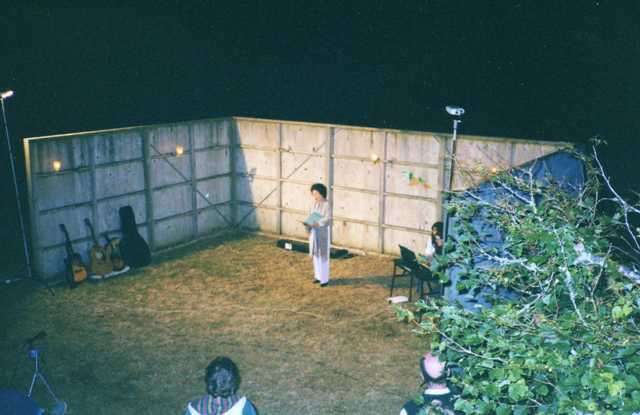
Fig.3-4-9 Mezzo-soprano singer Yuko Takahashi
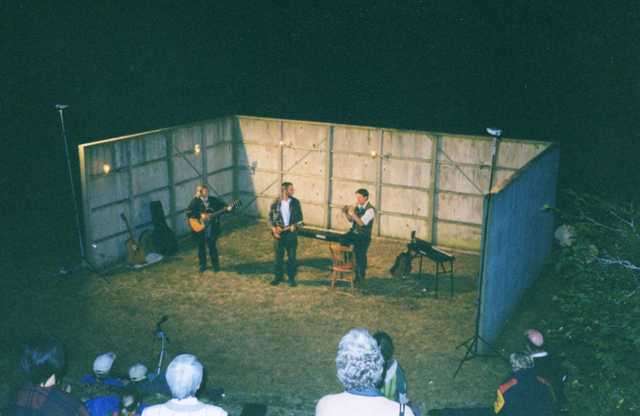
Fig.3-4-10 Local band of the Koanga Garden
(vi) Sixth music gathering on March 20, Sat, 2004
Finally, it is the day for music gathering. Once I got up at around
5am, but fell asleep again and was waken up by Kanji's phone. I asked
for a bit of shopping on the way. There is no wind but a bit cloudy, it
is very good for music gathering outside. I asked Othmar to bring his
tape recorder.
George came around 11am and started to do wiring. George, Norbert and I
had a light lunch. George did reshaping of the steps too. Norbert put
signs up, and assembled tables. With minor things it took until 5pm. A
DAT recording system wasn't good, but an old video camera worked well.
I could not do well both videoing and taking photos.
Before the program started the German choir arrived and I took them to
my veggie garden. I harvested 6 eggplants.
After I did a short opening speech, the music gathering started. The
German choir entered to the stage singing and performed.After this all
the groups were not yet ready and David Yu did a few solo performances
and four Japanese women filled the delay with their choruses. Thanks
for their cooperation for the program.
Gradually members arrived, and the Japanese drummers took the turn
having Akinobu's delayed arrive. The audiences all praised their
performances. They got more female drummers this year. In the end the
Maoris kapa haka group could not make it. Having the local band in the
end, the first part finished at 6:30pm.
Kanji told me he could not record on the DAT tape. Mario, Angel and
Shanty came, and I told them that I decided to have Angela's interview
of an Italian journal for sustainability to tell our project to Italian
friends, replying to their request which I got on the other day. They
were pleased.
Yuji, the main chef at a Japanese restaurant Tanuki, prepared foods
before the program started, served miso soup, rolled sushi, rice balls
and tempura to people. They were quite pleased with them as well. For
tempura, veggies from my veggie garden, pumpkins, potatoes, and
eggplants were used.
It was a bit earlier for the darkness. The first person to play in the
second part of the program was Tony who played the Irish pipes. Ross
did a Balinese dance with his daughter, Ayu's drum. A new performance
always gives us a fresh feeling. He said the dance should be played
with the dusk in the evening.
We got Austrian dances. David Yu gave me an impression that he did
quite a lot of practices. He sang with Andrew's piano.
The last program was the Japanese drums by 5 members which were the
highlights of the evening, and they got standing ovation. It was the
first time that it had happened for this music gathering.
The Austrian dances led by Erick were merry. This time we got newly
these performances as well as Balinese dances with visual expression.
They might have been satisfied with the Japanese drums and we got an
unusual cold evening, and they started to leave after 9 o'clock. The
audiences decreased almost to a half, when Othmar and Setsuko did the
last program on their duet.
After the music gathering, we talked to each other until late in the
night at the house. Othmar and George joined us too. We slept crowded
together around 1am.
Opening speech
Welcome every body. It is wonderful to see each other again after one
year. Last year I miscounted how often we had gatherings. This is the
sixth music gathering.
I have three things to say.
Firstly, I have to tell you the location of two toilets which women
have the priority to use. One is at the car park and another is a new
toilet in the house. It is located to the right in the porch. Please
take off your shoes there.
Secondly, it seems that we have more people this year, please do
consider where you are parking. Never break the traffic on Gibbons Road.
Thirdly, please be quiet while the performances are on stage. I think
that it is a very good opportunity to learn to respect other people.
Kaiwaka is a village of a small population, however, we have such a
variety of nationalities. We are very happy and proud to be together
enjoying music and talking for mutual understanding.
We again got a rich variety of performances on the stage last year.
Each one’s personality matched quite well to the stage
surroundings. The harmony created by the performers and the audience
was wonderful too. It was a gathering to have felt the warmth by people.
We enjoy the enhanced creative atmosphere by the increasing number of
people every year. The exchange of people’s personalities
always
inspires each other.
I think that non-reproduction is the important point of great arts. And
the flow and exchange between the performers and the audience has one
of the aspects. They leave a wonderful feeling. We can expect it this
year too, having time and situation changed, and we will create
different wonderful results. I strongly believe in that.
Indeed, in this structured society, it is very difficult to find time
and space where we can enjoy each one’s expression and
creation.
Today we have two parts having an intermission in between. The program
is;
German choir from AKL
Japanese drummers
Taiwanese singer
Austrian dance
Setsuko & Japanese ladies
Local Scottish and Irish music
Bamboo flute and Irish whistle
Balinese dance
Duets, Setsuko & Othmar
At the intermission, we will have a corner with tempura. Yuji, the
chief chef at Tanuki restaurant in AKL will cook it for us.Please enjoy
not only the taste but also the way of cooking.
Now, ladies and gentlemen, boys and girls, let’s enjoy
tonight together.
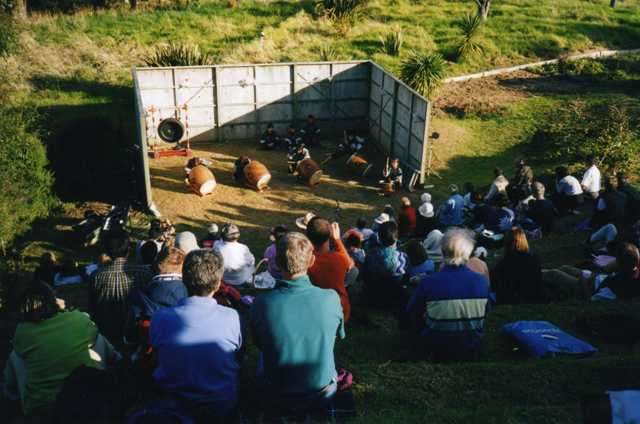
Fig.3-4-11 Enthusiastic plays of Japanese drummers
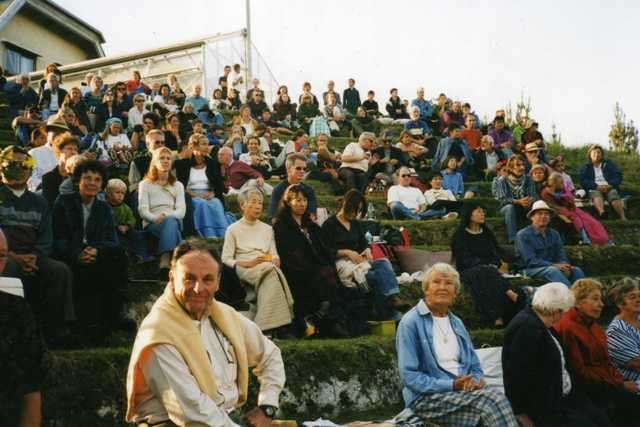
Fig.3-4-12 Increasing audiences
(vii) Seventh music gathering on March 19, Sat, 2005
Up at around 8am. We started with a bit of strain for today's music
gathering. After we had breakfast, George came at around 10am. After a
bit of talking he did the wiring and mowed the amphitheatre. When I was
watering, I got a visit from Lars friend, Denis. After having a glance
here, he left.
Lars and George finished wiring. Following Lars suggestion the main
step got a foot light. We had lunch by four. Lars went back home. Chris
came earlier then usual and worked with George putting up signs.
Following them Kanji arrived with Kanako. Afterwards, Midori and Kaoru
came and started to prepare for tempura cooking. Around 4 o'clock when
I was putting in candles, Barbara, Kevin and Derek, and Fung Yang
arrived. Successively Greg came. He got a light cold, but we had to
adjust the program practically. Fung brought chairs to the stage. Ross
came and I helped him to pass his drum over the bamboo fence. It was
unexpectedly heavy.
George and Marion arrived, Debbie, Mr. & Mrs. Takagaki,
Tatjana,
Nina & Lars came. Five couples for the Austrian dance came. On
and
on towards 5pm.
Around quarter past 5, I did an opening speech. Before the opening
there were not many people, but when I looked up to the audience I
noticed around 100 people.
I recognized the local band got all the members. They were the first
performers. Sarah as a pianist and Florian a guitarist newly joined the
band. The second was the Japanese drummers. Thirteen members with 5
drums did spectacular. After Greg read his poems, the Many Hands
performed. The semi-professional band played wonderful. It was
interesting Fung played an erhu of one string, a Chinese traditional
instrument, creating complex sounds. The Austrians danced successively.
They were as elegant as last year, but they must have been tired. The
last on the program were the solos of David Yu and Yeh from Taiwan,
which was the end of the part1.
During the intermission, I gave my harvests to Kevin, Derek and Fung. I
prepared a lot but I could not find enough time to give it to them.
Sorry about that. Tempura was well accepted as usual.
Part2 started at 8pm. The first was Ross, who had just recovered from a
serious sickness, thanks for coming. After the two Taiwanese singers,
the Japanese drummers played with 13 members. They were magnificent
again.
Marjke's son Kane, 14 years old, played the guitar. The second stage of
the Many Hands was wonderful too. Farrell played a Japanese bamboo
flute and an Irish flute. The local band took the place again. An
Australian poet read his poems as a volunteer.
I sang 'Soran' and 'Sukiyaki'. Humiko heard a few Japanese that joined
me and a Kiwi was singing the English version in the audience. Two
local volunteers sang successively. The music gathering of this year
was over.
They left by twos and threes. We went in the house. Four of Tanuki
restaurant, six of IPC Japanese drum team, seven of the AKL team, Kanji
and Kanako, all together twenty-one people enjoyed talking, forgetting
the night became late. Five of them left for AKL.
There is an expression 'Bring a plate.’ It is a habit that
they
make their favorite foods with a favorite amount and eat exchanging
with other people. They call it 'a Pot luck party' too. This time I
informed them to bring one's own plate. They brought not only cooked
foods but olive oil, honey, apples, pears, almonds, nuts mix even
beautiful flowers. This way gives us a hint of barter. Maybe we can
have this opportunity from the morning until a music gathering starts.
It was cloudy in the morning, fine during the day time. Again we got a
wonderful weather for the music gathering.
Opening speech
I am very glad to meet your smiley look after one year. I see some new
comers here and there. We welcome you all. Please have a relaxed day.
Do you have enough space around you to swing your shoulders? That's
good.
Firstly necessary information: Did you do park in a considerate place
along Gibbons Rd? Please never block the traffic there. There are two
toilets; one is outside and another in the house. It is a mouse time
please shut the porch door tightly when you use it.
Last year a collection box was handed around while I did not know. When
it was handed to me at the end, I thought it was an ice cream box. The
next day I found it was a collection box. The total money was $174.60.
I was worried what I should use it for. I concluded to donate it to the
local school. I don't want to have the same worry any more and I don't
accept any money even if it is a donation. We are really fortunate,
because we have such a peaceful day. I hope you do appreciate it in
your own way. One of the items on my sustainable project is to realize
a world where we do not have money. Please understand it.
Related to this point, I want to tell you that the performers today
never asked for money. I only spent telephone fees and
haven’t
spent much money. We got here today just with people's love. Could we
realize it better than such a way? However, I want to show my
appreciation to them with my crops: rice, veggies, fruits etc. They are
on the table and please take them.
Now, here is today's program. We will have three divisions: part1 and
2, and an intermission in between.
Performers are:
Japanese drummers: we have two teams together. One is the International
Pacific College student team driving a long distance from Palmaston
North. Another is a new team in AKL. Guitar and base with a Chinese
traditional instrument: Three members of the semi-professional music
group Many Hands were organized by Kevin. An electrical emphasis is
used here for the first time. They play with a guitar, a base and a
Chinese traditional instrument erhu.
Local Musical bands (Scottish, Irish music); they are from two eco
villages in our area. They play with a variety of musical instruments
as well as singing.
Taiwanese tenors; our familiar performer David brought his country
tenor. They sing with the accompaniment of Andrew. Austrian dance;
Elegant dancing team is led by Erick. They joined us last year
transferring their country's wonderful atmosphere.
Balinese dance; Ross was hospitalized two weeks ago. He is not
completely recovered, but he dances for us today. Bamboo flute; Farrell
who will chair the later half program will play a bamboo flute and an
Irish whistle.
Now, ladies and gentle men, Othmar who chaired a program and performed
and Setsuko who used to sing can not come. The German choir can not
come. We welcome volunteers. Part1 is chaired by Greg this time. Part2
will be done by Farrell who is a bamboo flute player. Joints among
performers will be welcomed.
Tempura will be served at intermission. Please enjoy it sprinkling salt
over to eat.
Anyway, we got a lot of performers again. Please enjoy the interaction
between the stage and the audience. I believe you audiences are
performers as well. And it will not be reproducible, and then today is
felt wonderful.
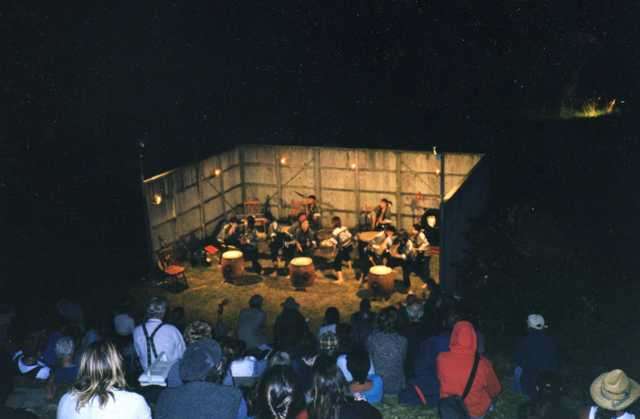
Fig.3-4-13 Japanese drummers with increased members
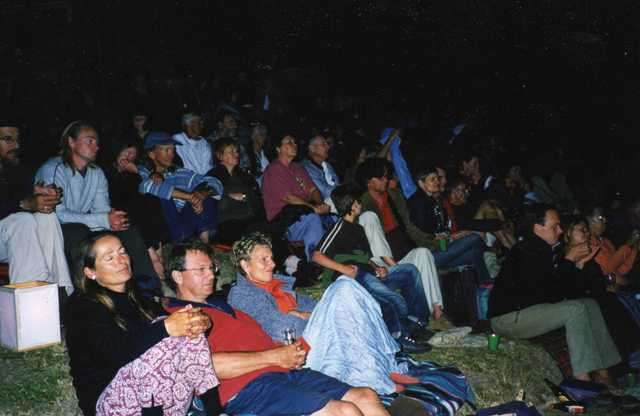
Fig.3-4-14-1 Audiences at part2
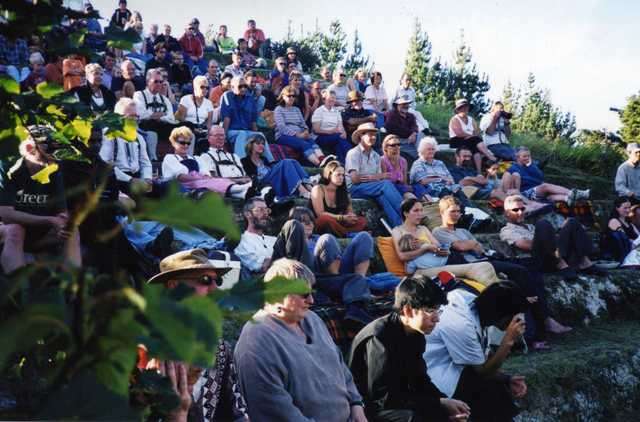
Fig.3-4-14-2 Audiences at Part1
(viii) Eighth music gathering on March 18, Sat, 2006.
Up 8am. It was cloudy but no threatening of rain. It was a big relief.
I set the lighting for the stage. I did a check up on the candle stand.
A box from the past left over was taken out from the shed. Japanese
lanterns for footsteps were placed.
Norbert put a fence around the pond. He checked the outside toilet too.
He set tables with Sniel who visited him here. The house rules were
written this time as follows and shown on sticks. The way to use the
inside toilet was given there too.
After you finish, press only the right pedal twice to give flushing
water and then both pedals together to expel. After this, press the
right pedal once to give additional water and expel.
Thank you,
Yoshi
House Rule
Out of respect for our performers and audience we expect silence during
the performances.
Parents please mind your children. Please don’t let them go
near the pond and cut trees.
No dogs.
Thank you
Yoshi
Kanji arrived with Kana around 2pm. I asked him to use a video camera
and Kana a digital camera. Lars came over around 2 pm and wired lines.
Kaoru and Midori came and prepared for tempura cooking. Kana helped
wash potatoes. Greg came around 3:30. We arranged and adjusted today's
program. The Japanese drummers safely arrived around 4 pm. My
neighbors, Jenny and Tatjana kindly offered us their land for car
parking. Many will stop along the road, but I did not hear any
troubles. This was another big relief.
This time many people came along. Looking at the audience, we started.
At the opening speech, I talked as usual and we appreciated the good
weather together. I sang a prayer song for a good day which I did
yesterday evening. After I introduced today's performers, I handed it
over to Greg.
The first performer was Alter Ego. Menno’s drum was with a
light
touch, John's bongo drum matched with Phil's delicate voice well. I
felt they were nicely united. A few kids were dancing around the
microphone for recording I had to ask them to be quiet or do it apart.
Thursdays did a good job, but it was too long.
Andy and his friends from Puhoi sang wonderfully without pa. The violin
sound added melancholy. John's Diggers followed. His mother from
Scotland scheduled to attend this music gathering. I think she was
satisfied.
The finish of Part 1 was the Japanese drums. They were good as usual.
The joint between IPC and AKL teams went quite well. They had separate
practices and jointed at KW. It's amazing.
I explained how to grow rice at the paddy. George, Marion, Min and so
on there were around twenty people. I got a lot of questions which I
appreciated. Tempura by Kaoru was popular. Later, Yuchan came and
cooked a few dishes.
At intermission, Saho, Midori, Tanya, Menno, John and Ross did a joint
drumming ad lib. It was the first try this time. It was a call for Part
2. A bamboo flute by Farrell showed the touch of Japanese culture. Yuko
sang two songs. She is really professional and refined. Ross directed
to ensemble Indonesian instruments. Kane played the guitar. Menno
joined him with his drums. Greg read his poems and sang songs. He is
universal.
The second performance for today was the Japanese drums. This time a
Pakiha Lindy and a Maori Tanya joined the drumming. Both of them were
once student members at the IPC. Midori came to me and said that a drum
does not sound properly because the membrane influenced by the humidity
increase that was caused by the temperature drop in the evening. I
heard the change and it was not clear indeed. A program will be needed
to think about it.
We saw stars in the sky and the moon was close to full. We were so
concerned about the weather today because a big storm was predicted.
Audiences started to leave around 8pm. When Gerd yodeled with Alter
Ego, we only had 20 people. Next year we will have to arrange a program
better and even a date.
After we tidied up outside, we enjoyed talking in the house. I
appreciated IPC students who raised the petrol fee by themselves.
Around 12pm Tanya and I visited Tatjana's. I left there leaving Tanya.
Finally a long day was over and I went to bed.
Opening speech
It is great to see each other after one year. We welcome new comers
too. First of all have you parked considerately? Are you seated relaxed
to be able to swing your shoulders easily? There are two toilets. The
way to use the inside toilet is given on the wall, please follow it.
Here we have a house rule.
Out of respect for our performers and audience we expect silence during
the performances.
Parents please mind your children. Please don’t let them go
near the pond and cut trees.
No dogs.
Thank you
Yoshi
Don't let your children to go to the pond and cut trees. Please be
careful of the wires around the rice paddy.
We were very concerned about today's weather. One month ago it was told
that it would be stormy. Yesterday I hung this doll and sang a song as
we did when I was a child.
-Sunny days boy, please give us a fine day. Just like a fine day which
came into my dream. If it will be fine, I will give you a golden bell.-
Here is today’s program;
Japanese drummers: One team is of International Pacific College
students. Another is a team from AKL. IPC students raised money for the
petrol to come. We appreciate that.
Diggers; finally the Kaiwaka local band got their name.
Ross and his family will play with Indonesian music instruments. A few
drummers are asked to join in.
A bamboo flute played by Farrell.
A few Japanese songs sung by his wife Yuko.
Country music sung by Steve from Maungaturoto.
Guitar solo by Kane, He is from Otamatea Eco village
Alter Ego from Warkworth with yodels
Andy Hamilton and his friends from Puhoi
Thursdays, Florian and his friends from near Tutu kaka
Still we are expecting Anthony to play Irish Pipes.
We have today’s performers from quite widely distributed
areas in Northland. We appreciate this very much.
My performance this year is rice. The rice you see in the right is
going to be harvested. They are all from the old roots. It will be
interesting to see what kind of results its shows in the way to use its
perennial. Please have a look at this at intermission. I will explain
briefly how to grow rice then.
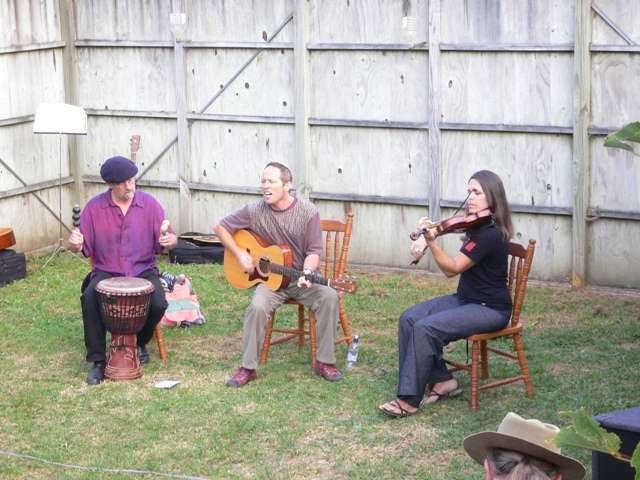
Fig.3-4-15 Local band from Puhoi
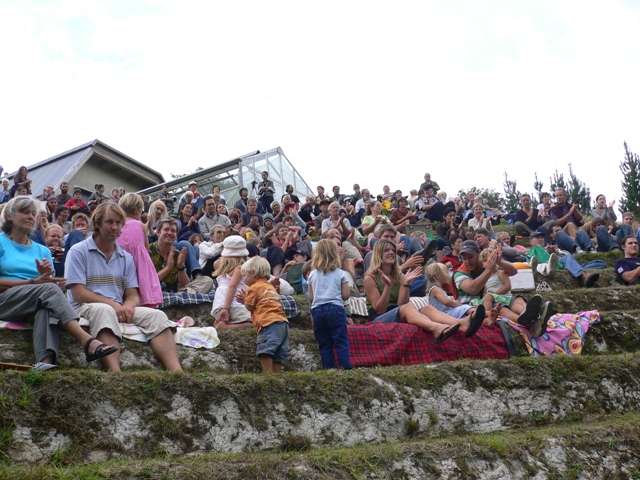
Fig.3-4-16 Increasing audiences
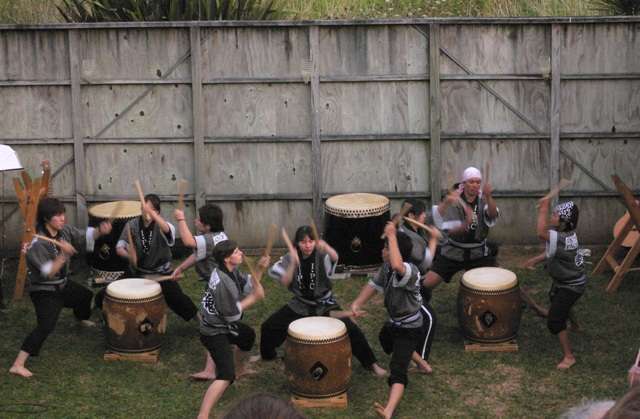
Fig.3-4-17 Japanese drums are always highlights
(IX) Ninth music gathering on March 17, Sat, 2007.
I got up at 7am. It's cloudy but the rising sun was peeping in between.
It looks that we will have good weather for today's music gathering.
Sunny day boy which I hung yesterday helped us, I feel.
Norbert got up earlier finishing breakfast. I finished it quickly. We
started to prepare for the music gathering. Candle stands for steps
were placed and the lights for the stage were installed. Signs were
taken out. Container full of water for hand washing was put next to the
outside toilet. Norbert set a few tables for foods and distributed
benches around. Rubbish boxes were given. George came along around 11am
and wired lines for power and recording. He made a good lining,
connecting a few points behind the stage. He got rid of spider webs and
checked candle stands on the stage. Finally, I put floodlights on the
stands at both sides of the stage. Norbert successively put up the
signs and tied a rope on sticks around the pond. Ebi arrived from AKL.
I asked him to do the recording system on DAT. Kanji arrived with Kana
and Wada. We seven went to the German Cafe for lunch.
The final set up started. Kanji put in the candles for the lanterns by
the footsteps and the seven stands surrounding the stage. Kana and Wada
did odd jobs. Kana took photos with a digital camera today and I
explained a location to take audiences from the back stage. It was a
good place to take almost the whole view of the audience. Ebi put all
the system for DAT recording by himself getting a line from George.
Brian came over with Pier on his van. They put Japanese drums and other
gears out by themselves.
Kaoru arrived at quarter to five pm and prepared tempura cooking in the
kitchen. Othmar and Setsuko arrived. We arranged the program for Part1.
The AKL team and student team of IPC, Palmerston North did a light
tuning. The student team was with the first and second year grade
students.
Now, finally we got the time to start. As usual at the opening the
audience were not a large crowd, say around 50 people. I started my
short opening speech at 5pm.
Thursdays changed their name to the Shed and asked to start the
program. The second turn was Diggers but no performers yet. We asked a
Chinese tenor John but the piano was not ready. Othmar did a good job
in the meantime with his jokes. While the piano was on the stage, we
asked Farrell to play a bamboo flute for 'Haru no umi (Spring Sea)'.
His wife Yuko, a mezzo-soprano soloist, accompanied with the piano. It
reminded me of the Japanese harp Koto music and I enjoyed his play so
much. I was a bit sorry because the piano sound was a bit too loud. But
I asked him to play next year again.
Setsuko and Othmar played a piano duet. They are a wonderful music
couple.
Now, Japanese drums. The drums were made by Brian with wine barrels and
their sound was a bit softer than the Japanese ones which are usually
made with a big tree trunk. Today I felt they have a certain taste.
Anyway they were the highlights as it is at every gathering.
Brian played as the only male member enthusiastically. Midori and Yuna
played vigorously, Saho did delicately, a German drummer Pier played
bouncing, each drummer did it expressing each one's expression, I think.
At the seventh, we had Austrian dances with their ethnic costumes. One
or two mistakes happened but they gave us grace.
At the eighth Net volunteered to sing with his guitar his and two of
his original songs.
Finally Diggers' members were ready having their new member at Koanga
Garden and sang folk songs.
At intermission I was asked to explain our project and I did this with
a poster at the stage. Acoustic friends from AKL, Graham, Sili, James
and his family and Min came to me. Around 20 people surrounded the
poster and listened to me. A man wanted to take it on his videotape and
I had to hold a microphone. It took about 15 minutes.
Part 2 was chaired by Greg. He played his guitar as the first
performance. It was too long and affected the later program delay.
Successively Japanese drums were played. Lindy joined them at Part 2.
The audiences were very happy with their performances.
Stephe played country music with Pedro's guitar. Kimiyo, who brought
her electrical piano, sang a few songs suggested by Yuko. Kane worried
us a bit as it was delayed but he was fit in. It looked like he gets
used to singing with an amplifier and he think it was not loud enough.
But I spoke to him on the stage from the top of the hill and told the
reciprocal of a sound that I hear him as he hears me. He is a good
musician having a fine voice.
David Yu entertained us very much. He did calligraphy of his song on a
large sheet of paper and sang it. For the second he wrote the title of
a Japanese song and sang it. He got applause for his expression.
Jane sang two, an aria and a Himalayan song in Chinese with her
wonderful soprano voice.
Successively, Shed and Diggers played. This time music gathering was
over.
Othmar, Greg and I greeted and I told them the tenth music gathering
date has to be considered on Wo Mad. All remaining performers came back
to the stage and greeted the audiences of more than 50.
This year I was often asked if we would find one's left things, even a
cat. I will have to work hard tomorrow morning. On the other hand, many
people came to me and appreciated us. I felt that since I heard all the
appreciation it is worth going to all the hard work for the preparation
for the music gathering.
Othmar and Setsuko sang a song among people. I joined them a bit too
loud and people ran away from us.
After people left we started to chat in the house. I explained this
project to the Japanese drummers and other people on the night. The
real human cooperation is to find out the soul world having the
spiritual development. I hope they understood me.
Midori told me that she was getting married not to Kaoru but another
man in Osaka. A few people who will leave for AKL early tomorrow
morning went to bed and I followed.
Opening speech
Joys are necessary and important for our lives. However, one can not
obtain it easily even if it is well planned. It comes to us without a
notice. One thing is for sure that if we look for it with many people
together, we get more of an opportunity to get it. Let's enjoy the
ninth music gathering together.
As usual I ask you a few issues: Two toilets location and its use,
considerate parking, care of children etc. Now I give you to Othmar who
has come back after two years absence.
(X) Tenth music gathering on March 8th, Sat, 2008
I got up at 7am. It was misty but looks to be good weather for a music
gathering which would be the last one. I appreciate God to have given
us such nice weather for all 10 music gatherings.
I had my lonely breakfast and started to work for listed preparations.
I eliminated a few bucketfuls of water in the long drop of the outside
toilet. I filled water into a container for washing hands.
Mieko, my daughter, was brought back from Eva’s by George. He
went to the bus depot to pick up Fumiko but he came back and he
couldn’t find her. She came over around 11 O’clock
with
Takahashi on a rent car. Successively Yasuko and Mari came. I was
concerned at how much Yasuko had lost weight, but they were quite
cheerful. They went back to AKL after a few words because of their
appointment. I put up signs with Takahashi who came from Yokohama with
Fumiko. George mowed my neighbor’s paddock for car parking.
Tables were set. We got sandwiches from the German Café and
enjoyed lunch with seven people.
I put house rules and signs up for the children on sticks with Mieko.
We started to extend power lines. Brian came alone with Japanese drums
around 2 pm. They were supposed to have a work shop with Saho, but they
were delayed and it was not held. Stephe brought his PA and set them on
the stage to let it be used for the first performer Jack and then he
went back to work.
David and Ryu came earlier and did brush writing for his performances.
Setsuko and Othmar arrived in separate cars and took a piano directly
to the stage.
While George and Ebi did the rest of the wire lining, I had a quick
shower. Lars was just in time for the start and did the DAT tape
recording. He said he was extremely busy these days.
I asked Ebi to do the video shooting and Yoko to take photos with a
digital camera. Jim was supposed to do the video shooting but I could
not find him.
However, we got time to start and the last work of preparation. When I
finished printing out of the program, Greg turned up. I gave the
program to Othmar and Greg and started my opening speech.
Steve had checked it beforehand and I just read it where I looked back
at the past nine music gatherings. I appreciated the performers and the
audiences. I told them that I decided to quit the music gathering from
today onwards because I turned 70 years old and I thought to spend my
time left for a sustainable way of living. They all sang me happy
birthday. And I passed on to Othmar. The first performer was Jack who
is Tatjana’s brother. He has a soft and delicate voice and
wonderful talent as she also says.
Diggers made us worried but were just in time. Though Bob moved away,
they performed with the full members, John, Wolfgang, Daniel, a woman
drummer and a guitarist. They contributed for a long time to our music
gatherings. Thank you very much.
Finally, the third was the Japanese drummers. Their live sound is
really wonderful, especially the low sound. It is impossible to replay
with any electrical devices. When I saw their members, most of them
were foreigners: Australia, Brazil, Germany, NZ, and USA. Only three
out of ten members were Japanese. The audience enjoyed them. Andy and
Mad Hatterf were shifted to the first of the second part.
Greg covered it with tuba and a guitar string play. I remember that the
tuba originated from Mongolia.
Successively, Setsuko and Othmar did a piano duet. They are very
musical lovebirds and contributed to the music gatherings from the
beginning. Thank you very much.
Farrell played Haru no Umi-Spring sea- with a bamboo flute being
accompanied by another Yoshi’s piano. I like the tune very
much.
It harmonized with the piano very well. I enjoyed it very much.
In the meantime Yuji arrived and started to cook tempura. Kaoru came a
bit later too.
Successively, Yuko, Farrell’s wife, sang two songs. One was
an
Okinawa song whose CD I often listen to. It was sung by a professional
singer, but her one sounded much better. I’m always impressed
with her well trained and strong voice from a slender body. They are
musical lovebirds too.
Menno took two other drummers and they showed a nice joint drumming. He
has wonderful talent with an African drum.
Part 1 finished around 6pm as scheduled.
I had started drinking wine, and enjoyed sushi rolled by Setsuko and
tempura by Yuji and Fumiko. Fumiko helped me to put my poster on the
reflection panel and I started to explain this project.
About ten people came to me and I got earnest questions. Mieko said she
was surprised to see a couple whom she met in Nelson where she stayed
for a language school. I finished it 10 minutes to 7pm following Lars
suggestion and Part 2 was started.
Greg chaired it. He gave us a good contributor too. I missed talking
with people at the intermission.
The first program was by Mad Hatterf. A woman violinist was swapped to
a man. The violin sound gave a special atmosphere. Menno joined them
with a drum.
The Japanese drummers performed second that was the last time to see
them here. I felt tears coming and went into the house and drank wine.
When I was told that IPC students could not come and Saho was in Japan,
I contacted Brian. He strongly supported us to come. Saho got here in
time to show her leadership and they played powerfully and wonderfully
for us.
Stephe sang a few country music next. He is a local singer and came
finding time from his busy time. Jack sang a few as a volunteer. He is
a Kaiwakan too. Three happy songs were played by five Japanese members
with ukuleles. The audience burst out laughing. Tatjana asked me where
I found them.
The German choir from AKL had a few years absence but performed with
six members whom I remember from the first music gathering. I hugged
each member at the end of their performances.
The members of the Sakuranokai choir from AKL were completely changed.
They did nice too.
David Yu sang a Chinese song showing his calligraphy behind and having
his friend Ryu to drink Chinese sake. It was a wonderful show.
Setsuko sang a song with her clear and charming voice.
The last performer was Subhash for a tabla. Sue gave me a phone call
from New Plymouth and this opportunity was realized. He talked with the
audience through music and I felt it does not need any words.
Now it was the time to say good-bye. Performers came back to the stage
and sang Pokarekareana all together. It was after 9pm but more than 100
people were remaining.
I was quite drunk but I enjoyed every moment again. I did a farewell
speech. Thank you very much for everybody.
I heard a few whispers to have an amphitheatre at their places. I said
I will help them with my best, acoustically and for the organization. I
felt that there was something that was already starting to grow.
The last music gathering was over. I saw them off and we went in the
house.
Ten Japanese drummers, Farrell and Yuko, Fumiko and Takahashi, and
Mieko remained and we chatted and enjoyed the time.
Opening speech for the 10th music gathering
This is our tenth musical gathering. This is possible because of
people’s cooperation and love.
This amphitheatre was constructed for Acoustic research purposes, for
instance, the effect of sound reflection over audiences on a steep
slope, and the acoustic behavior of a rectangular enclosure related to
musical performances. We have not done much research on them yet. We
will leave that for later joy.
Heidi and I planned the first musical gathering and held it on March
30, 1996. We got a professional pianist for Brahms, Nichole Nulden, a
German choir and a Japanese choir from AKL. They gave wonderful
performances in front of about 70 people.
I had a strong desire to have a musical gathering under the twinkling
stars. This desire was realized on March 25, 2000 in the evening, it
was our “night for sound and light”.
The third music gathering on March 24, 2001, was in both the day time
and the night time, as the later musical gatherings were. That night we
had a chanting choir of seven Japanese monks from 天台宗魚山声明研究会.
There was an international conference of religions at Praha,
Czechoslovakia in the year 2000. They were invited there and did a
spontaneous joint performance with a Gregorian choir. They left a
strong impression on the audience. Later in 2006, they made a CD. One
of tracks will be played at intermission. It is said that music started
as a prayer to God. I hope that music will be a way to break a barrier
between religions.
At the fourth music gathering in 2002, a few local musicians and
musical bands started to come and perform.
At the fifth musical gathering, Japanese drummers joined us. Since then
they have become one of the highlights.
At the sixth musical gathering, we had Austrian dances, Balinese dances
and showed visual entertainment. The variety of performances has
gradually increased as well as the audience.
Wonderfully and successively, we had the seventh, the eighth, and the
ninth musical gatherings with a variety of enthusiastic performers and
we enjoyed every gathering very much.
Finally, we have the tenth musical gathering today. It has been a great
experience to learn what we can do with people’s cooperation
and
love. It also has proven that this creation can be the cultural
foundation for a community.
Using this opportunity, I want to convey how much I appreciate all the
performers and audiences for having created such wonderful musical
gatherings.
Over the past days I have been reviewing and thinking about the musical
gatherings. I have concluded to have a break for at least a few years.
The main reason is that I am seventy years old and the rest of my time
is quite limited for my sustainable project. I still have a lot of
subjects to finish.
My other reasons are that this little amphitheatre can not hold more
people and there are a few dangerous spots for children, shortage of
toilets and other necessary facilities etc.
I hope that this sudden stop will produce a new creative future
development in some shape, leaving various feelings and thoughts in
your mind.
We want to record and video tape today’s performances to make
a
DVD later. We have Lars for recording, Jim and Ebi for video taking.
At intermission, for people who want to learn more, I will explain this
sustainable project up to this stage, using a diagram. I will play a CD
of a joint chanting of two religions as well.
Now, I hand you over to Othmar. Thank you.
The fact that we did this ten times tells us the importance of mutual
respect and love and a confident “We can do.” It
also
showed us that joyful life is very possible with people’s
love.
We can do anything if we do it with motivation and confidence and love
that is what I leant.
Resume
At the amphitheatre which we constructed for the Acoustic research
purpose, we got the tenth annual music gathering for autumn on March 8,
Sat, 2008. Every year we get more performers with more variety, and
each band improved their performances with practiced and finer
expressions.
Before all, I feel glad and happy that they never asked for any money.
Accordingly, I can open it without any charge. And people bring their
cooked dishes, own brought nuts, honey, fruits, flowers etc. We share
them with each other. There we find joy and creation. I think everyone
enjoyed this opportunity in each one's way. This is a very important
point for the individualism that I believe.
Any performers who got the information of our music gathering mouth to
mouth offer us to join. Every year it has been becoming more joyful.
If we have a rich nature, with a little thing over there or a tiny
off-cut we want to make something or express something with them. They
are not to show for others but to enjoy by themselves. Doesn't the
origin of arts exist there?
Born in Kobe, from a corner of Osaka where I lived for long time, I
live now in a corner of New Zealand doing this sustainable project. I
could not imagine the present situation just 15 years ago. This must be
said as a command of God, nothing else.
Indeed, after having a lot of travels in the world, closed minded
nations are Asians especially Japanese. New Zealanders easily move
around in their country and go overseas to the USA, Africa etc. From
the great universe it is a tiny distance to travel, but quite
meaningful for one's life. We Japanese have to change from shutting us
in our own country. It will be a real step toward individualism, I
think.
When I turned 70 years old, I decided to quit the music gathering by
the 10th, because I have a lot to do for the sustainable project. As I
mentioned at the opening speech I got many people’s help.
They
helped me with genuine and rich minds. I appreciate all of them from
the bottom of my heart.
And I got the confidence that we can do. It gives me wonderful
possibility and courage to construct a utopia village with sustainable
way of living.
If we do things with a number of people, we can have different
dimensioned joy and can learn a lot, I believe.

















